18. A COLD WAR DEVELOPS

THE COLD WAR SPREADS
The 1950s
CONTENTS
 Stalin dies ... so who's now in charge in Stalin dies ... so who's now in charge in
Russia?
 The 1953 East German uprising The 1953 East German uprising
 The 1953 Iranian coup d'etat The 1953 Iranian coup d'etat
 The French abandon Indochina (1954) The French abandon Indochina (1954)
 The "Third World" forms at Bandung The "Third World" forms at Bandung
(April 1955)
 The rearming of Germany ... and the The rearming of Germany ... and the
creation of the Warsaw Pact (1955)
 The Suez Crisis ... and the Hungarian The Suez Crisis ... and the Hungarian
uprising (October-November 1956)
 American paternalism in the Western American paternalism in the Western
Hemisphere
 Castro's Cuban revolution Castro's Cuban revolution
 European rule under challenge in Africa European rule under challenge in Africa
The textual material on page below is drawn directly from my work
A Moral History of Western Society © 2024, Volume Two, pages 266-281.
STALIN DIES ...
SO WHO'S NOW IN CHARGE IN RUSSIA? |
In
early March of 1953 Stalin experienced a stroke … and died five days
later … with much mystery surrounding the unexpected development.
Apparently, he was considering another round of extensive purges within
the upper circles of Communist leadership to further fortify his
position and it was thus rumored that he had been poisoned … a rumor
easy to believe given the way political fortunes in those days rose and
fell in the most deadly of ways.
In any case it raised the question: who was now in charge of the
Soviet Empire? It was immediately announced that Georgy Malenkov
was the new Chairman of the Council of Ministers (something like a
Prime Minister) … with Lavrentiy Beria continuing in his position both
as Deputy Chairman of the Council of Ministers … and as head of
Internal Affairs (operating the NKVD or secret police). The
Foreign Ministry would continue to be directed by Molotov.
Nikita Khrushchev (Soviet leader 1953-1964)
Yet while Soviet public office was important, Communist Party
leadership was vastly more important. And here, Nikita Khrushchev
was quick to take the position of leader of the party Presidium … that
September (1953) taking the position as the party's First Secretary
(Stalin's former position).
But Beria as head of the NKVD was a dangerous contender for power … and
Khrushchev and Malenkov – fearing that Beria was actually planning a
full takeover (and their deaths) – worked together in having Beria
arrested (late June), tried, and then shot (that December).
But this now put Khrushchev and Malenkov in political competition … as
Malenkov attempted to have the State take the lead in a post-Stalinist
Soviet Empire … offering a program of social reforms. But
Khrushchev countered by offering his own "reform" program … at the same
time securing his position among the lower ranks of the party
(following Stalin's example). Bit by bit, Malenkov lost status in
the political dynamic … until in January of 1955, Khrushchev was able
to get the Supreme Soviet to replace Malenkov with a Khrushchev
loyalist, Nikolai Bulganin … offering Malenkov only a less important
position in the state presidium (cabinet). Clearly now Khrushchev
had full control of the Soviet regime, both party and state. |
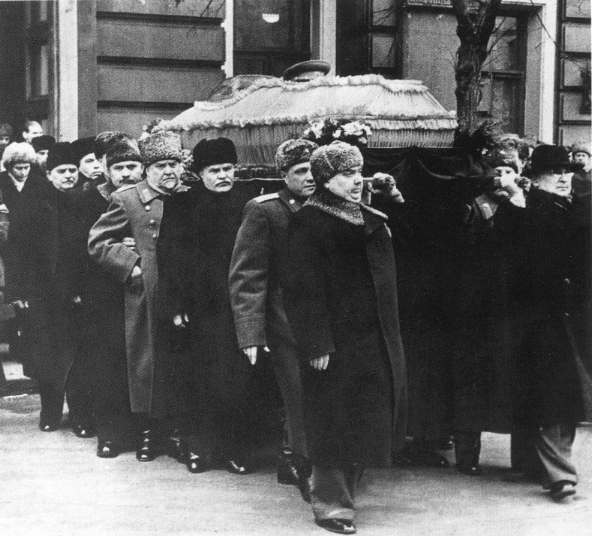
Stalin's successors carry
his casket from the Kremlin - March 1953. Meanwhile the
question becomes critical concerning who was then leading the Soviet Union.
There were a number of possibilites:
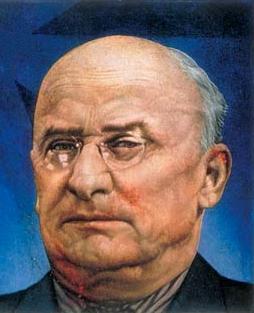 Lavrentiy Beria (head of
the NKVD)
Lavrentiy Beria (head of
the NKVD)
... and the most feared of the leaders
TIME Cover, July 20, 1953
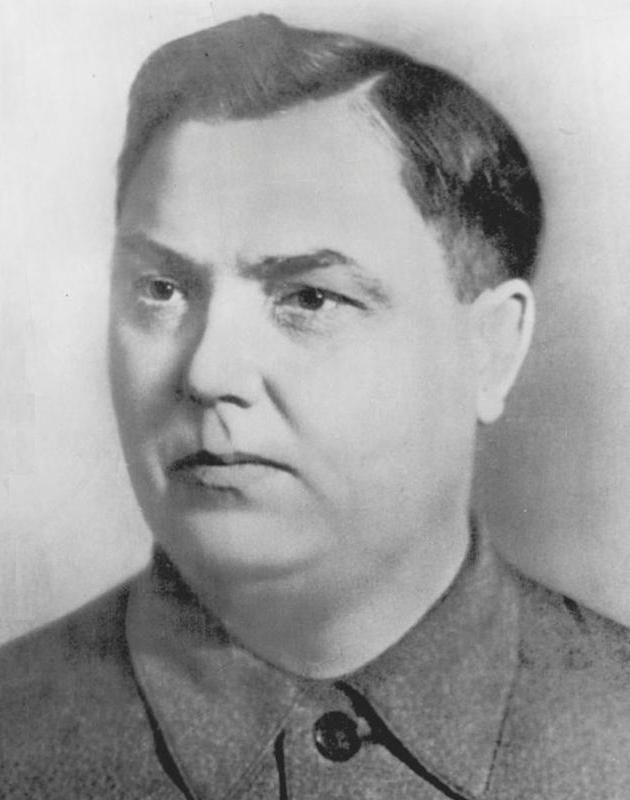 Georgy Malenkov (new Prime
Minister) Georgy Malenkov (new Prime
Minister) Vyacheslav Molotov (Foreign Minister)
Vyacheslav Molotov (Foreign Minister)
Magnum
Photos
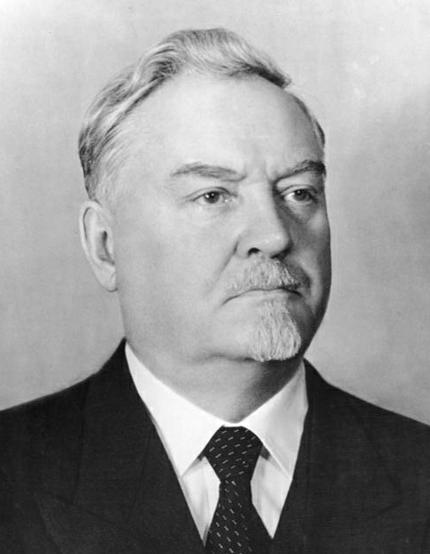 Nikolai Bulganin Nikolai Bulganin
Bundesarchiv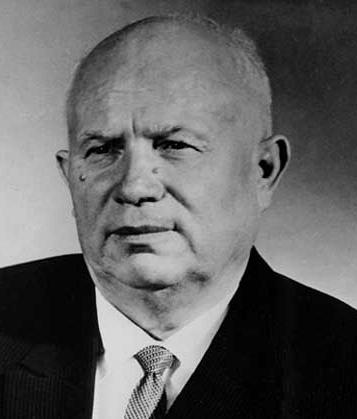 Nikita
Khrushchev
Nikita
Khrushchev
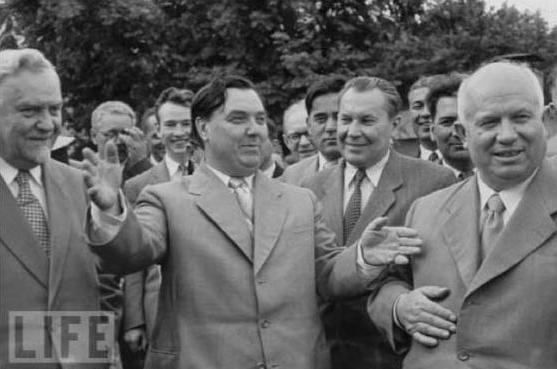 Bulganin, Malenkov and
Khrushchev
Eventually emerging as the
new leader of the Soviet Union was Nikita Khrushchev
Bulganin, Malenkov and
Khrushchev
Eventually emerging as the
new leader of the Soviet Union was Nikita Khrushchev
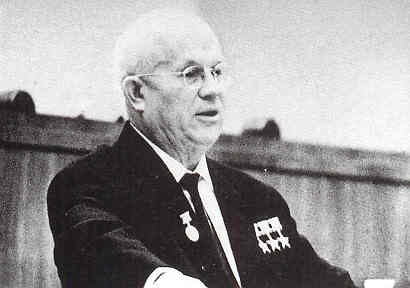 Nikita Khrushchev announcing
the "de-Stalinization" of Soviet Communism -- in order to give Communism
a new face or new look -- the 23rd Party Congress in 1956
Nikita Khrushchev announcing
the "de-Stalinization" of Soviet Communism -- in order to give Communism
a new face or new look -- the 23rd Party Congress in 1956
Russian Federation
THE 1953 EAST GERMAN UPRISING |
Meanwhile,
having heard talk of a possible loosening of Moscow's political hand
since Stalin's death, East German workers – ultimately nearly a million
of them – took to the streets, demanding that the Communist dictator
commanding their country, Walter Ulbricht, also loosen up on his
oppression.
Actually, the event had been building to the point of such explosion since the previous year.
There had been much talk of rearming West Germany … possibly as part
of a new (West) European Defense Community. But the fear of a
rearmed West Germany was what brought dictator Ulbricht to tighten his
grip on East Germany, taking greater control over his country's
industries – and even undertaking the collectivization of East
Germany's farmlands. But the latter move sparked farmer
resistance by their cutting back on food production, which in turn led
to deep hunger in urban East Germany. East Germany was thus very
restless as it entered 1953.
When a massive revolt finally broke out across East Germany on the 16th
of June, the Soviet collective leadership was quick to respond by
sending on the following day 20,000 Russian troops to join some 8,000
East German police … and quickly and ruthlessly suppressing the
rebellion. In the process, the arrest, imprisonment, and even
execution of East German participants was extensive.
Ulbricht was quick to blame the West for inciting the rioting with its
propaganda campaign conducted by Western literature distribution and
radio programs directed at Eastern Europe … and did what he could to
block such Western efforts.
But for the new American President Eisenhower, the game was not
over. In July he announced the offering of food supplies to any
East Germans able to get to American distribution centers in West
Germany. Of course Ulbricht did what he could to stop this
maneuver. But it even made Eisenhower's European allies concerned
that this move merely increased East-West tensions, rather than
relaxing them the way they were hoping a change in Soviet leadership
might produce. Thus Eisenhower terminated the food program that
October.
All in all, nothing much seemed to have resulted from all of this …
and things quickly settled back to more normal patterns in Europe.
|
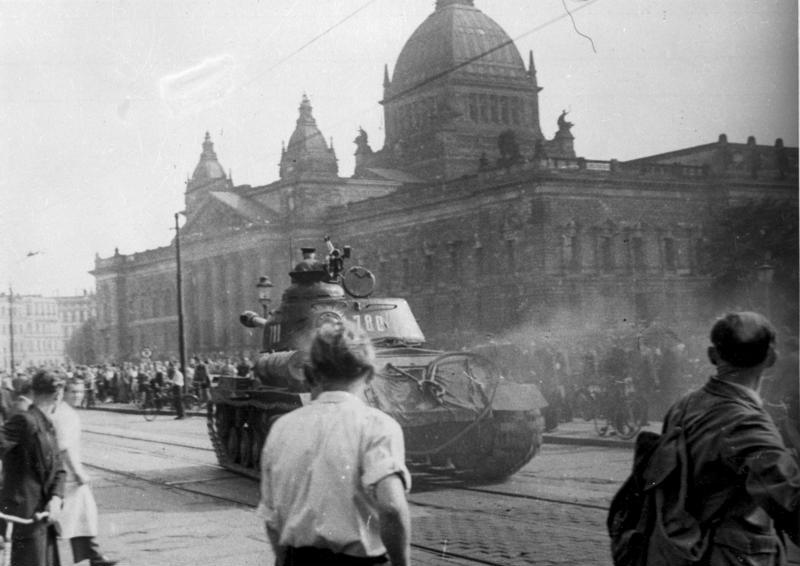
Soviet tank in Leipzig to
put down the East German strikes - June 1953
Deutsches Bundesarchiv
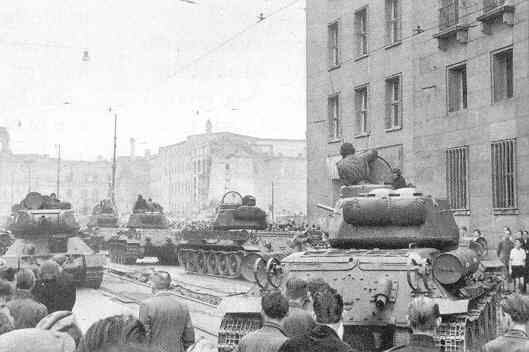 Soviet tanks in East Berlin
to put down the strikes
Soviet tanks in East Berlin
to put down the strikes
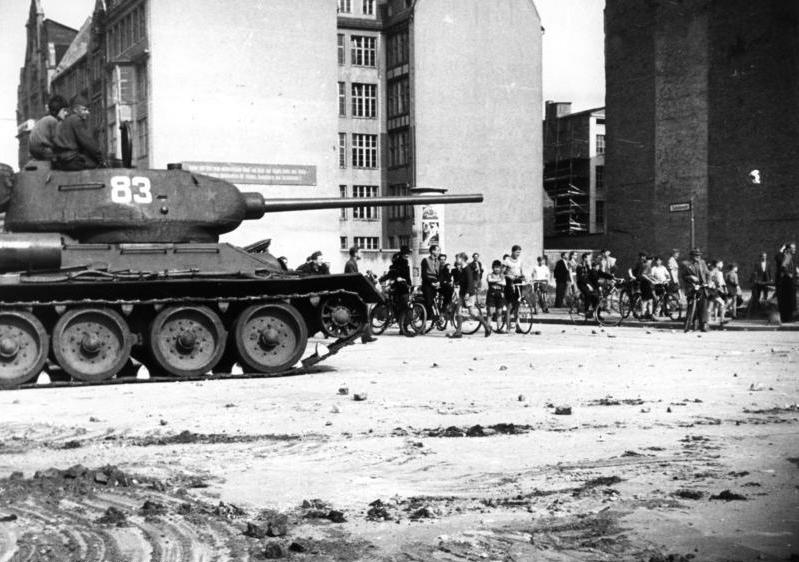 Soviet tank in East Berlin
- June 1953
Soviet tank in East Berlin
- June 1953
Deutsches Bundesarchiv
THE 1953 IRANIAN COUP D'ETAT |
But
that was also because Cold War tensions were rising elsewhere at that
point: the Shah's Iran. Iran found itself in a very tricky
position. The Soviets had demonstrated their strong interests in
the country – neighboring Iran sitting atop huge oil reserves, plus
commanding a strategic position overlooking the flow of much of the
rest of Europe's oil resources out of the Persian Gulf. At the
same time, the British actually controlled Iran's oil production …
vital to British industrial capacity – but also a major sore point for
the Iranians themselves. And Truman's America was rather
unsupportive of such European imperialism … although Truman was growing
increasingly concerned that every step-back of its European allies from
their imperial positions abroad usually resulted not in constitutional
democracy coming into being but instead a nationalist dictatorship
taking over the "liberated" country … a dictatorship strongly supported
by the Kremlin. And now as Iran entered the 1950s, it looked as if that
same challenge was about to hit that country.
Iranian politics themselves were indeed quite tricky. There were
several political interests lining themselves up against each other in
a bid to take over the country. The young Shah himself actually
played a rather restrained part in Iranian politics … allowing the
Majlis (parliament) and the prime minister to take the lead in shaping
Iranian politics.
But Iran's Prime Minister, Mohammad Mosaddegh, (as of 1951) was intent
on building up his own power position even more by playing up Iranian
nationalist sentiments massively through an effort to have Britain's
oil industry in Iran nationalized. The previous prime minister,
who had opposed such nationalization, was assassinated by a militant
Shi'ite group headed up by the Ayatollah (Iran's religious leader)
Abol-Ghasem Kashani,1 who was working hard to bring his Shi'ites to
power as Iran's governing group. And then there was the Iranian
Communist Tudeh Party, also pursuing the same goal … although
politically they were a relatively small group.
When in late 1951 Mossadegh's National Front finally nationalized
Iran's oil industry, all this tension exploded. The British did
all they could to stop the move – pulling out their technicians and
imposing an embargo on Iranian oil in the hope of forcing Mossadegh to
return things to British control. Then they found themselves
deeply disappointed when Truman was unwilling to support them in this
effort … despite the fact that they were supporting American troops in
Korea. But Truman was more focused on Korea than Iran at
the time. And besides, all this helped to promote the American
oil industry greatly!
As for Iran itself, the embargo brought deep financial trouble to the
country … as well as much political turmoil – as the various groups
accused each other for the mess that was clearly developing. And
both Kashani's Shi'ite Party and the Tudeh Party were gaining strength
in the process. Consequently, Mossadegh countered by hardening
his grip on Iran, in mid-1953 closing down the Majlis and arresting
political opponents … merely deepening the anger tearing the country
apart.
At this point, the American CIA, under orders of America's new
President Eisenhower – with cooperation from Churchill, who had
returned to power as British prime minister in 1951 – pressured the
Shah to dismiss Mosaddegh (which the Shah had every right to do) and
appoint in his place Faziollah Zahedi (mid-August 1953). But
Mosaddegh refused to leave office, arrested a number of political
figures, forced Zahedi into hiding … and encouraged his supporters to
take to the streets in loud protest over the "attempted coup."
At this point, the Shah decided to head off to Italy to wait out the
crisis! And then things quieted down with Mosaddegh securely in
power.
But here too, the game was not over. The CIA used its funds to
encourage an unsuspecting Tudeh Party to take to the streets to
demonstrate clearly their own support of Mosaddegh … which the CIA then
used most cleverly by portraying Iran as facing a possible
Mosaddegh-supported Communist coup … something the CIA knew would
enrage the vast majority of Iranians! Of course Mosaddegh had no
such interest in a Tudeh Party coup. But the ruse worked.
In reaction to this supposed Mosaddegh-Tudeh plot, huge numbers of
pro-Shah protesters (joined by Muslim protesters) took to the streets,
at the same time allowing Iranian military officers to have Mosaddegh
arrested and imprisoned (August 19) … and replaced by Zahedi as Iranian
prime minister. So … the crisis was over.
The Shah then returned to Iran – accompanied by the American Secretary
of State John Foster Dulles. America now had a very strong ally
in the form of the young Shah of Iran!
1Kashani
was the mentor of the Ayatollah Ruhollah Khomeini, who would take
control of the country after the Shah was overthrown in 1979.
|
When politics in Iran takes
a Leftward turn in the early 1950s, America intervenes
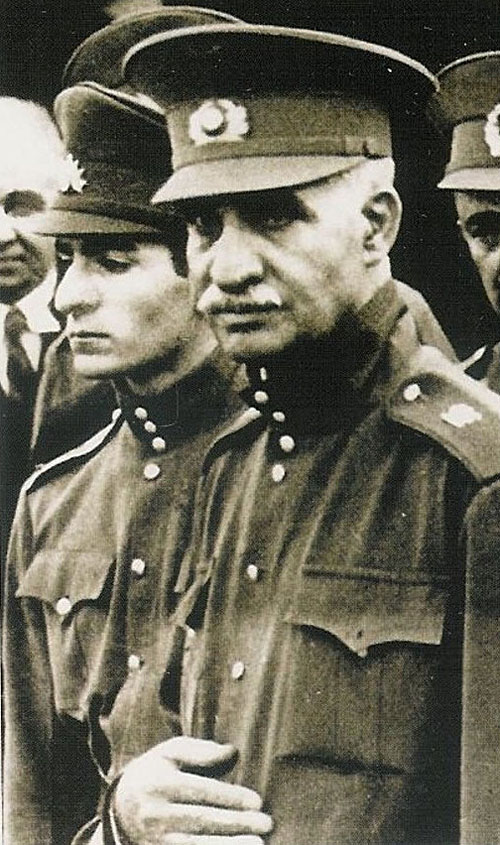
Reza Shah and his son
Mohammed
Reza Pahlavi
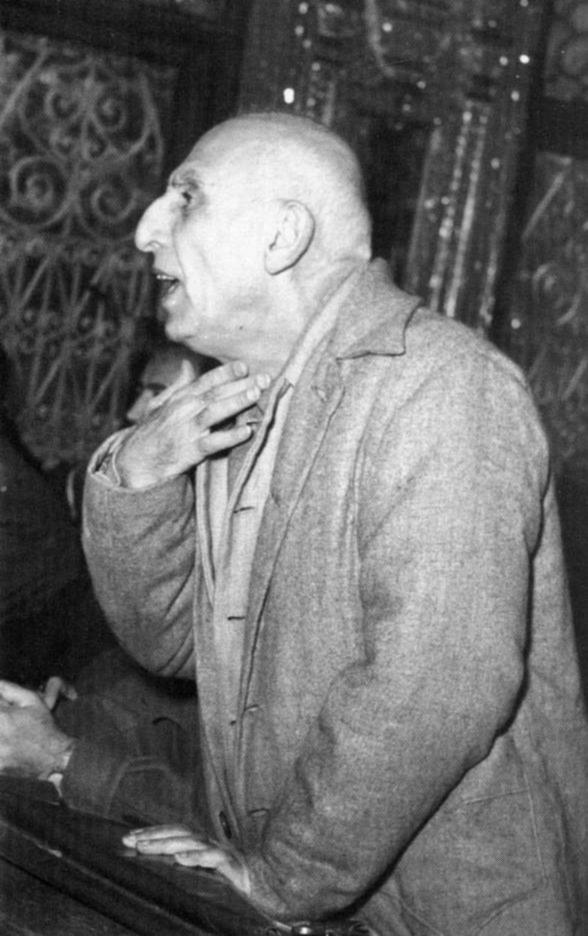
Iran's former premier Mohammed
Mosaddegh on trial as a "Communist" after his ouster by a CIA-directed
coup - 1953
 Iranian soldiers surround
the Majlis (Parliament) building in Tehran - August 19, 1953.
Iranian soldiers surround
the Majlis (Parliament) building in Tehran - August 19, 1953.
Iran's Cultural Heritage
Organization
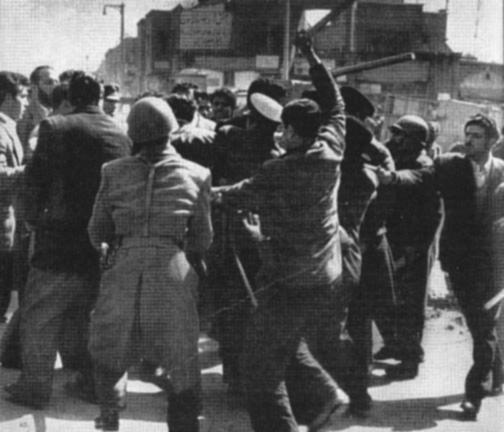 Iranian protesters during
the coup
Iranian protesters during
the coup
presstv.ir
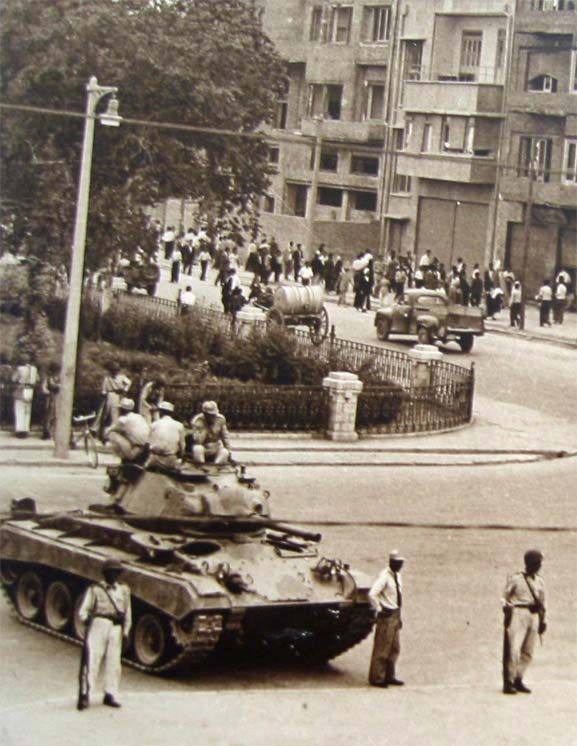 Tanks in the streets of
Tehran
Tanks in the streets of
Tehran
 General Zahedi (Coup Leader)
and Ardeshir Zahedi (his son)
General Zahedi (Coup Leader)
and Ardeshir Zahedi (his son)
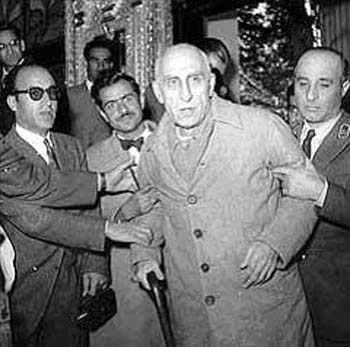 Mossadeq on military trial
in Iran - 1953
Mossadeq on military trial
in Iran - 1953
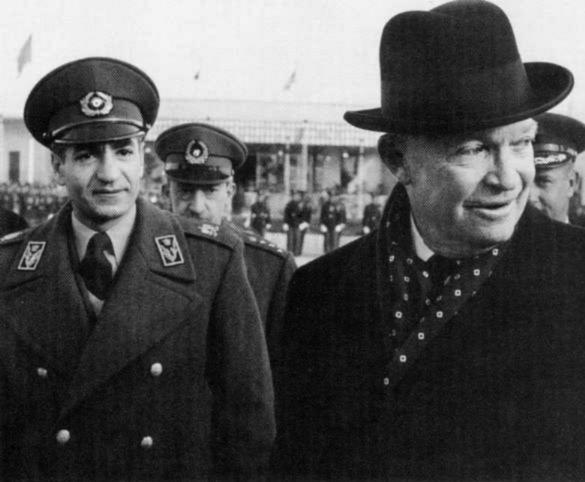 The Shah of Iran is visited
in Teheran by his benefactor, President Eisenhower - 1959
The Shah of Iran is visited
in Teheran by his benefactor, President Eisenhower - 1959
THE FRENCH ABANDON INDOCHINA (1954) |
Neither
the French nor the Vietnamese had given up in their fight for control
of Indochina … with battles raging back and forth between the two
parties. But from the Vietnamese point of view, they had nothing
to lose by continuing the battle … whereas the French were finding the
effort very expensive, with no real rewards for the effort … and
consequently were growing tired of the enterprise. The French
were good at running down and defeating small groups of the Viet Minh …
but more would continue to pop up. At one point Vietnamese
General V Nguy n Gi p even extended the battle into Laos, just to wear
down further the French resolve to hold its position in
Indochina. Then when fairly successful French General Jean De
Lattre grew ill and died, the French resolve declined further.
Dien Bien Phu (1954)
At this point (November 1953) the French attempted one major assault
into Vietnamese territory, dropping 1800 paratroops into the huge and
strategically placed Dien Bien Phu valley … from which they could send
out patrols to hunt down Viet Minh units. But Gi p realized
immediately that the French had put themselves in a very vulnerable
position, with the valley surrounded by high hills from which
Vietnamese artillery could bombard the French stations … as well as
destroy the airstrip by which the French received ongoing supplies –
food as well as war materiel. And finally well positioned to
undertake such an attack on the French, in March of 1954 Gi p began his
attack on the well-surrounded French forces. With the monsoon
season also beginning at this point, there was no way that French
supplies could even be dropped successfully into the valley.
The 1954 Geneva Accords
It took only two months for the French to realize that they had been
defeated in a most humiliating way … at a time in which discussions
were already underway in Geneva concerning the future of
Indochina. The French were finally ready to admit defeat.
In the 1954 Geneva Accords, Vietnam was divided North and South
temporarily … "North Vietnam" designated as the Democratic Republic of
Vietnam, under the presidency of Hồ Ch Minh, and "South Vietnam"
designated as the State of Vietnam, under the Emperor Bảo Đại.
But elections were to be held throughout Vietnam no later than July of
1956 to unite the two halves of the country.
Failed national elections. But in October of 1955, Bảo Đại's
prime minister Ng Đ nh Diệm deposed the emperor, proclaiming the
Republic of Vietnam with himself as president.
Then as it came time to hold the 1956 elections, it was very clear that
the elections would go strongly in favor of Hồ Ch Minh as the
president of a united Vietnam. Thus Diệm refused to hold
elections in the south, claiming that his part of the country was "not
ready" for such elections. His people needed a bit more time in
order to understand fully the dangers involved in a vote destined to
bring on a Communist victory.
Does this sound familiar? This was the same excuse the Communists
used earlier in blocking such elections in Korea. Anyway, now it
was Diệm's turn to put forward this lame excuse … because he had the
full backing of Eisenhower's America in taking this position.
|
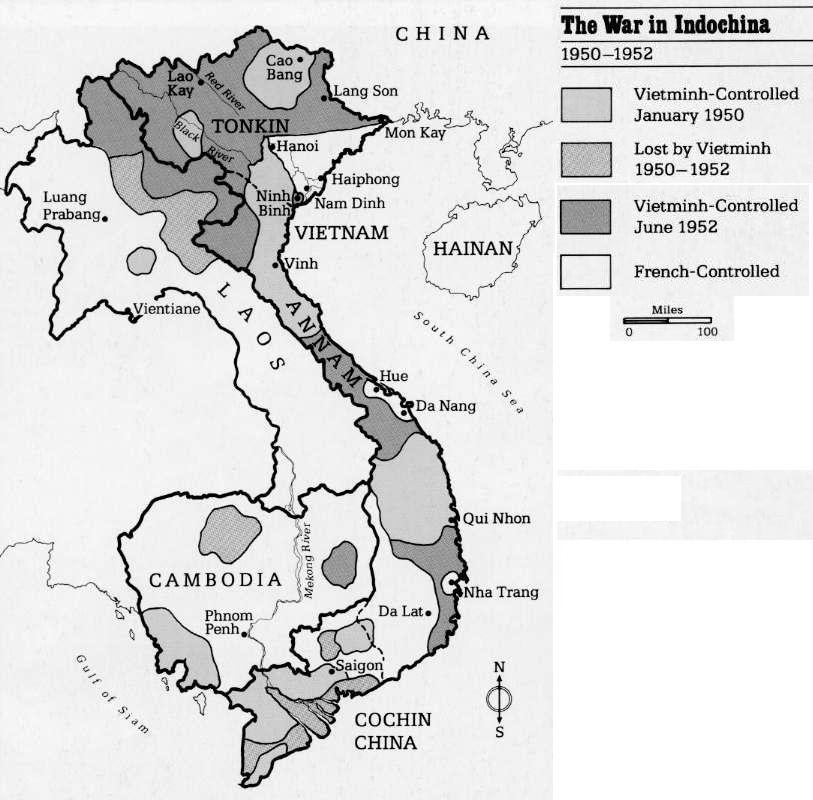
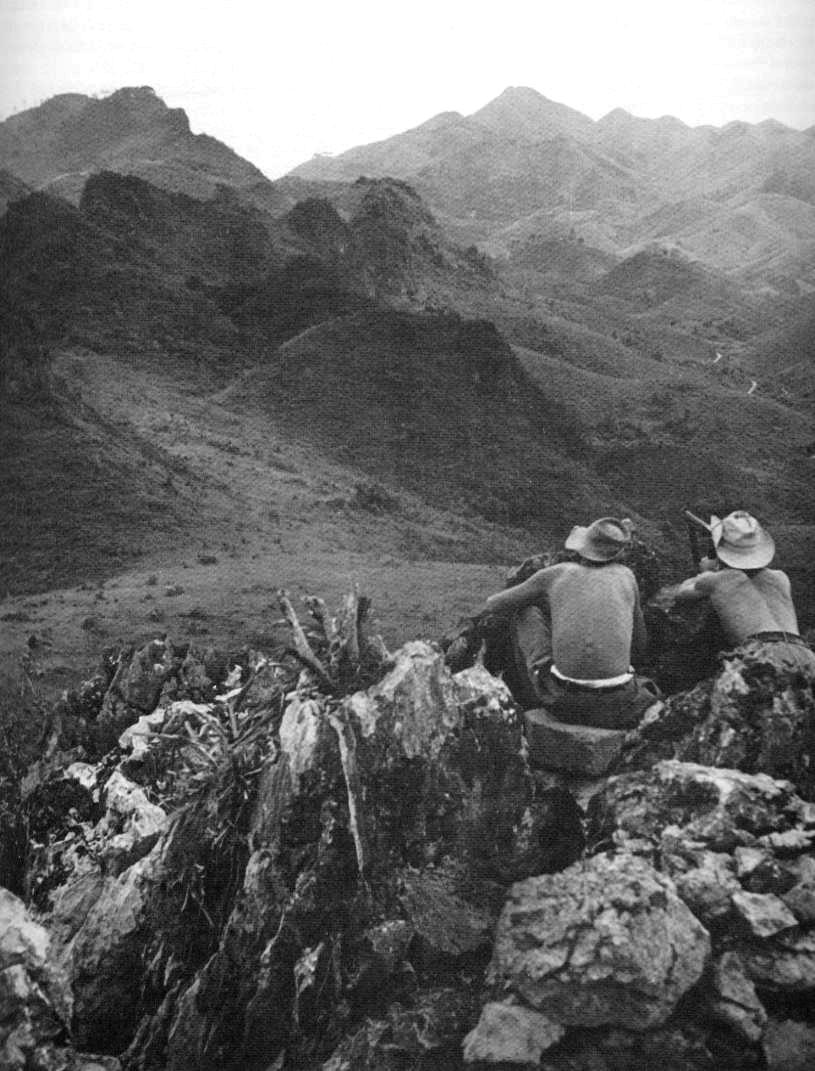
French troops at Dong Khe
defense position prior to the Vietminh attack
which overwhelmed the French
- 1950

French troops pushing a truck
up muddy Route Colonial 4 along the Chinese border
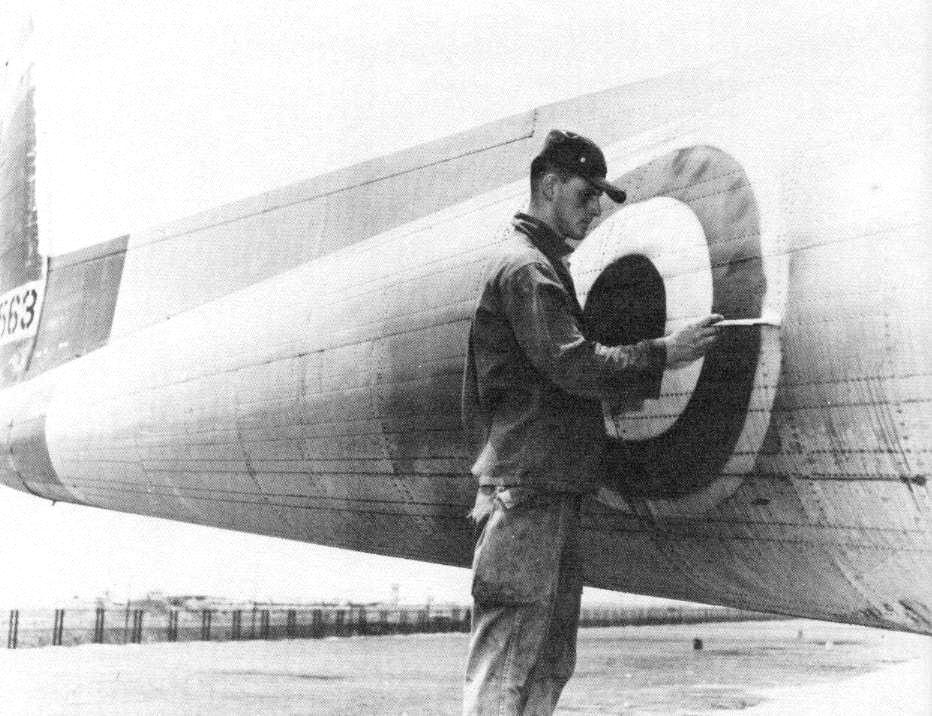
French tricolor insignia
being painted over the US insignia as it arrives at the Haiphong air
base
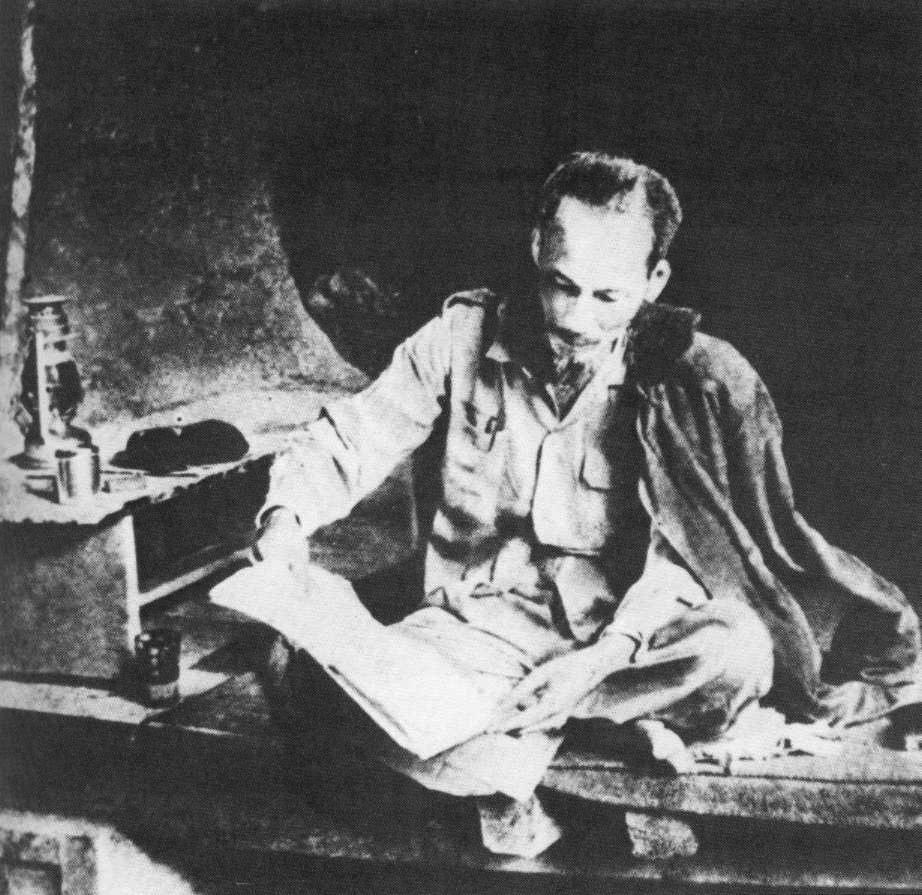
Ho Chi Minh in his mountain
headquarters in 1951
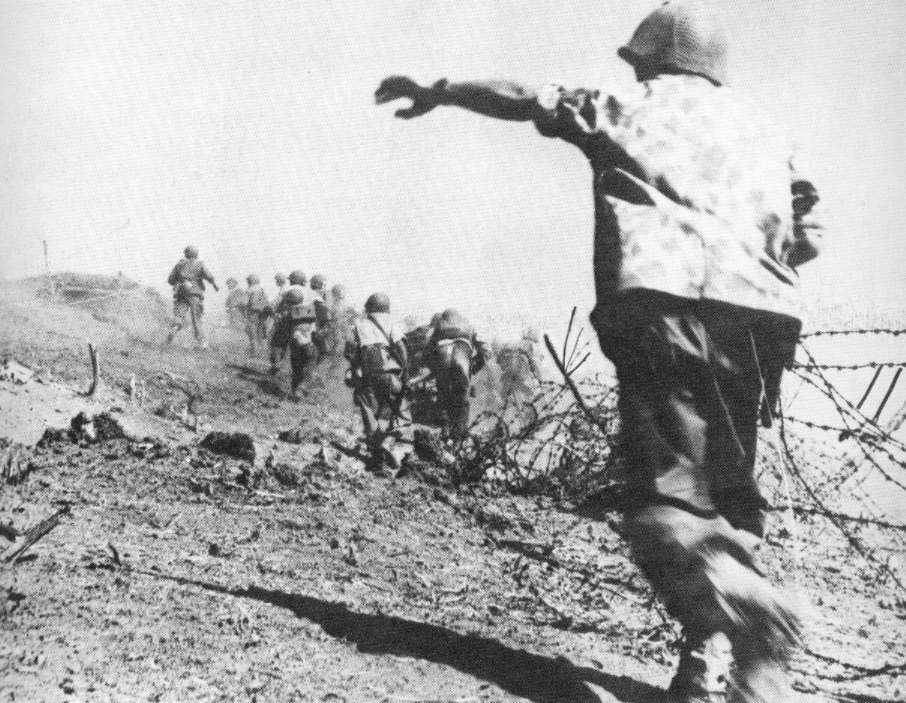
The French victory at Na
San - 1952
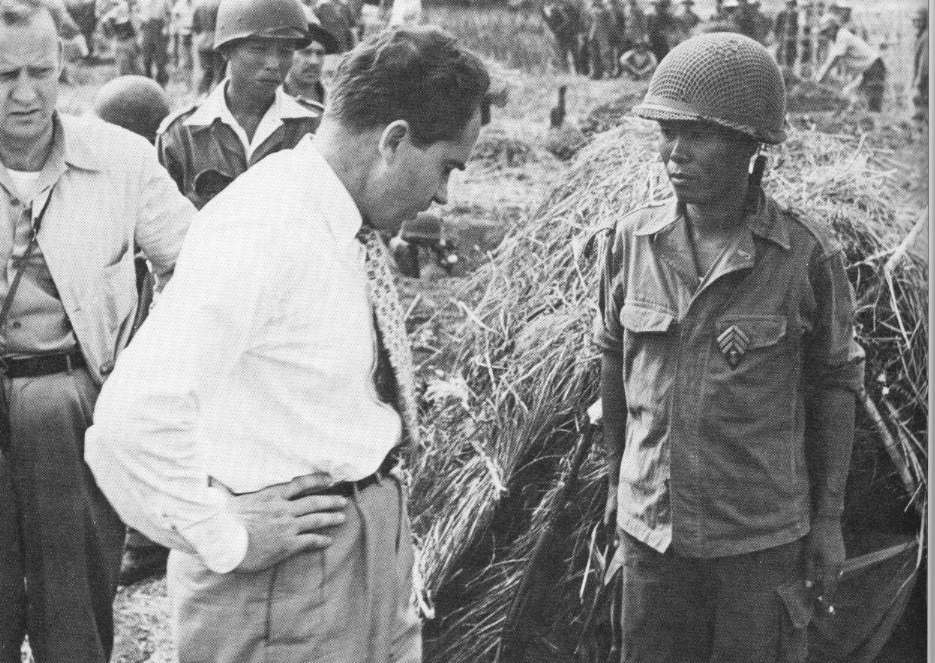
Vice President Richard Nixon
visiting Vietnamese nationalist troops - late 1953
The French last-stand at
Dien Bien Phu - March 30 - May 7, 1954
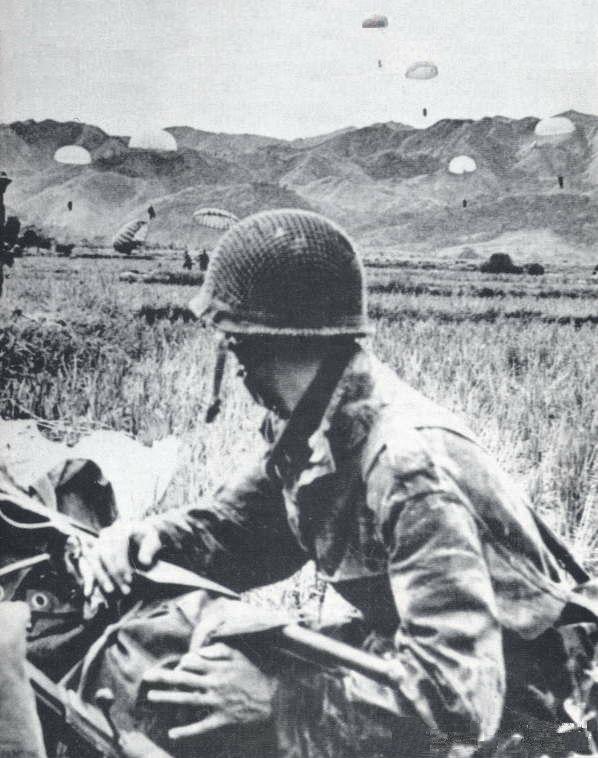
French Foreign Legion
reinforcements
parachute into Dien Bien Phu on March 16, 1954 - two weeks before the massive
Communist asault on the main camp
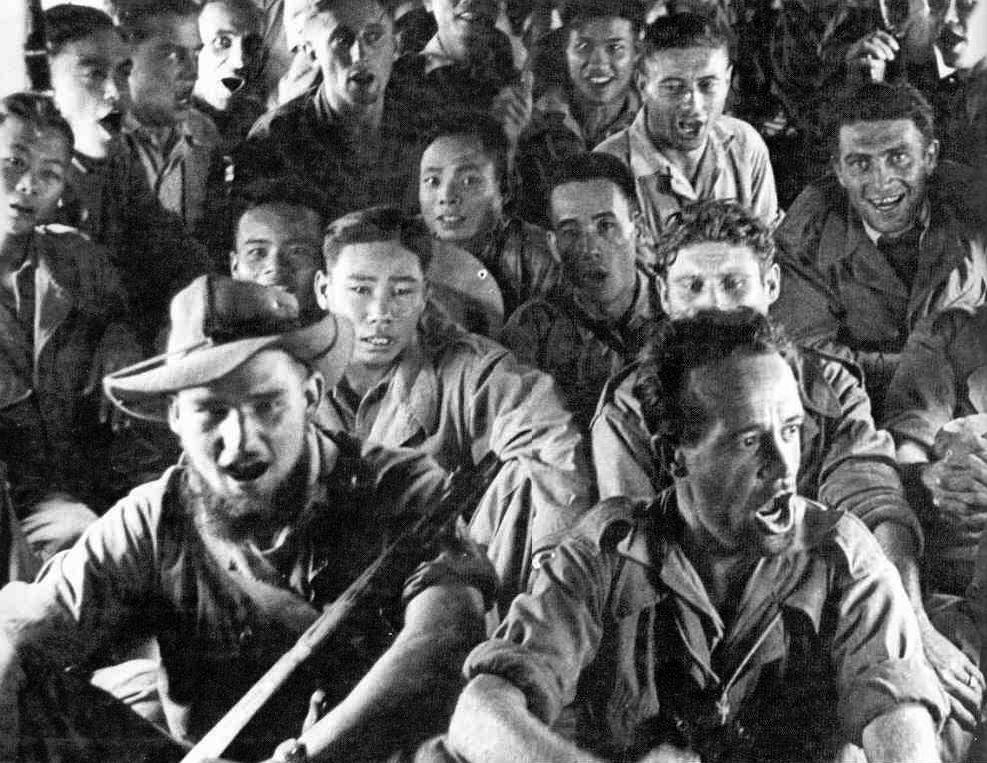
French Foreign Legionaires
(in this photo mostly Czech)
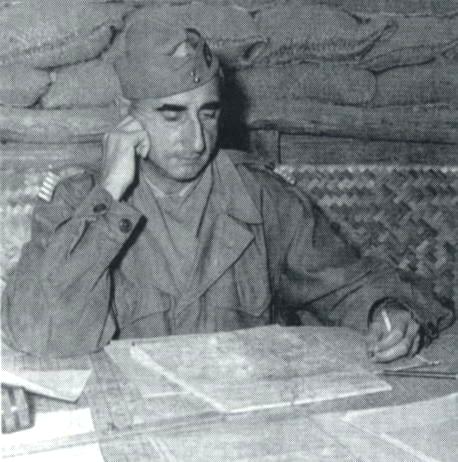 Colonel Christian de Castries,
the garrison commander at Dien Bien Phu, rarely emerged from his
underground bunker
Colonel Christian de Castries,
the garrison commander at Dien Bien Phu, rarely emerged from his
underground bunker
National Archives
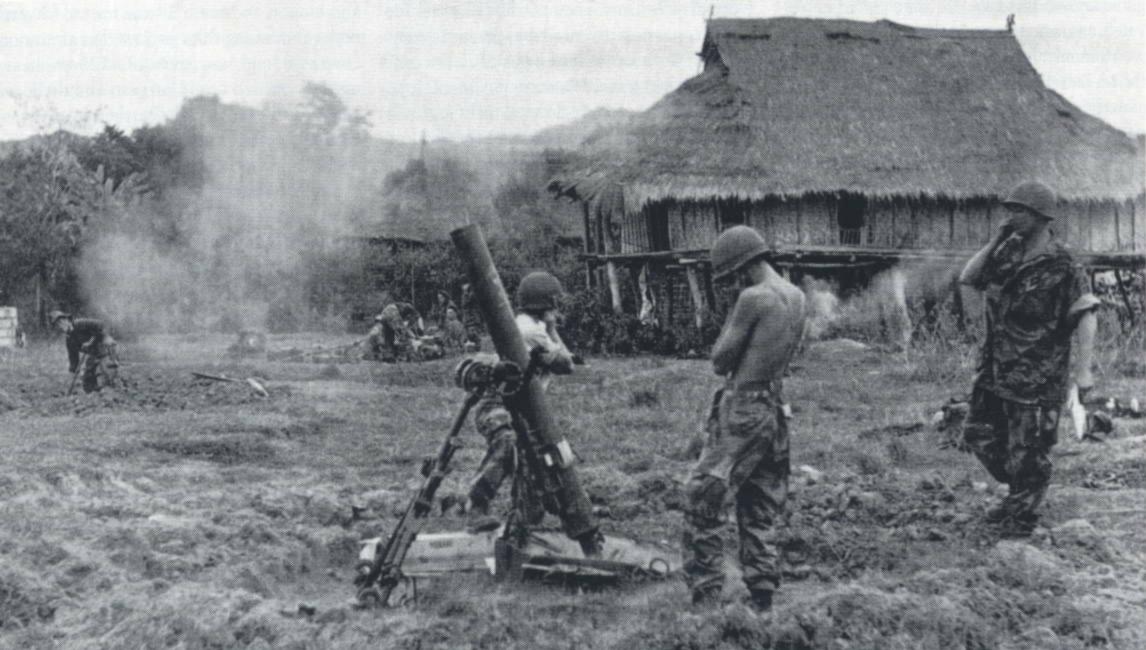
A 4.7 inch mortar line in
action dujring Operation Castor.
Huts in the background were
torn down to clear fields of fire and build defenses
National Archives
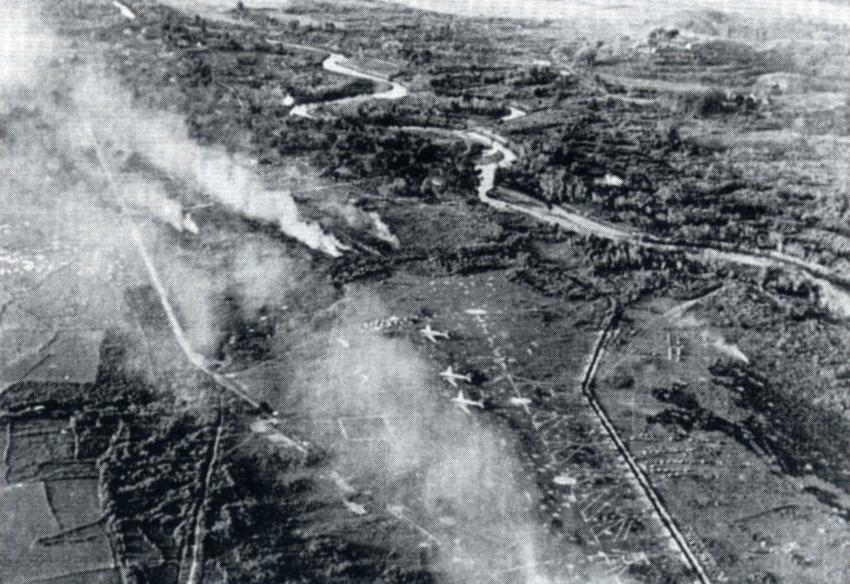
The smoke-shrouded airstrip
at Dien Bien Phu was closed in late March
1954 after heavy Viet Minh shelling
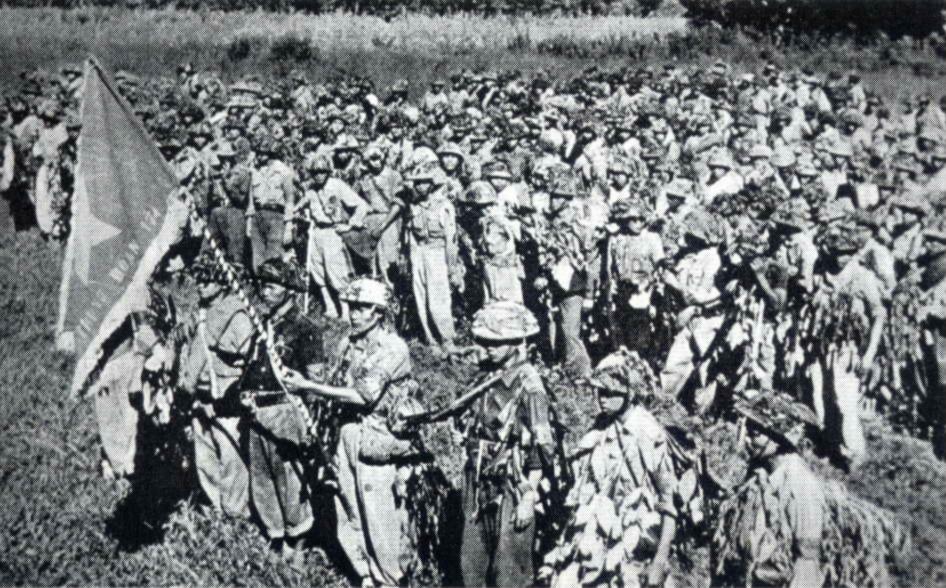
Highly trained and motivated
Viet Minh troops mass for combat against the French
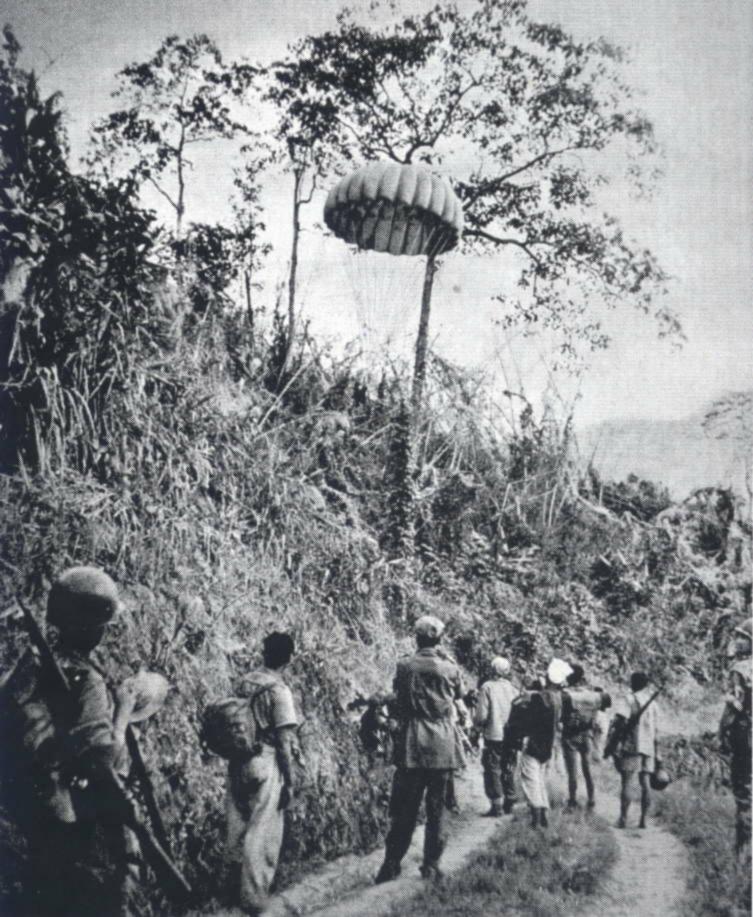
Hard-pressed French and
Vietnamese
soldiers wait for airlifted supplies
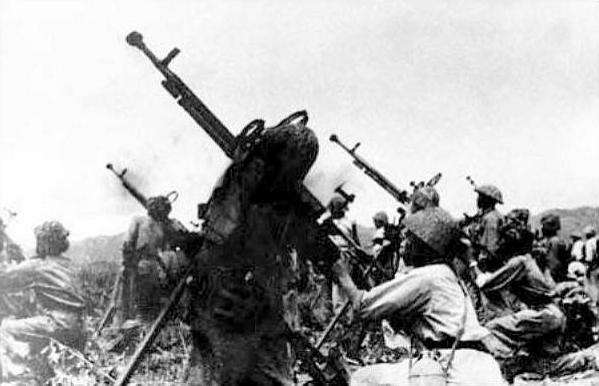
Vietnamese blasting away
at surrounded French troops - Dien Bien Phu
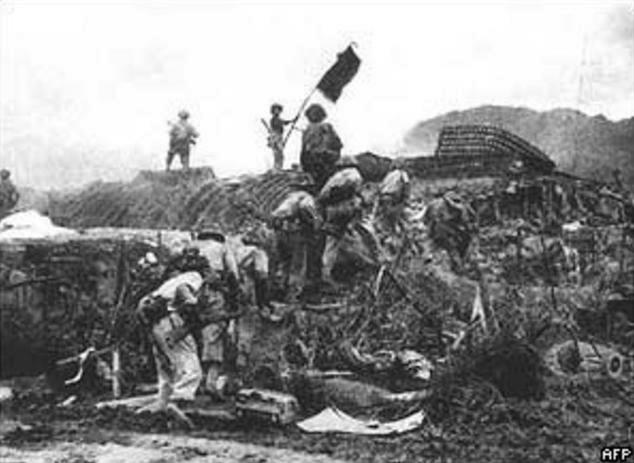
Vietnamese raise the flag
of victory over the French forces at Dien Bien Phu - May 7, 1954
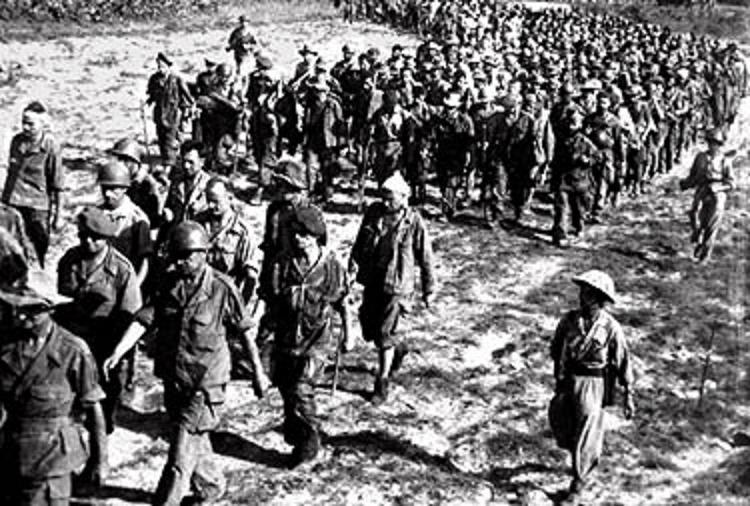 French troops taken prisoner
at Dien Bien Phu
French troops taken prisoner
at Dien Bien Phu

Communist Viet Minh forces
enter Haiphong shortly after the French surrender at
Dien Bien Phu and soon after the US Navy
evacuates French troops from the port city
The 1954 Geneva
Conference
convened to settle the French-Vietnamese conflict
(April 26-July 20, 1954)
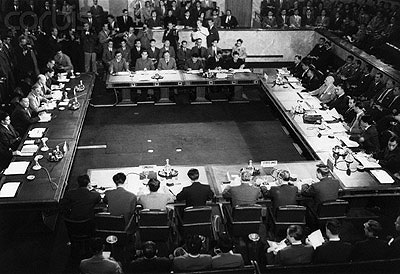
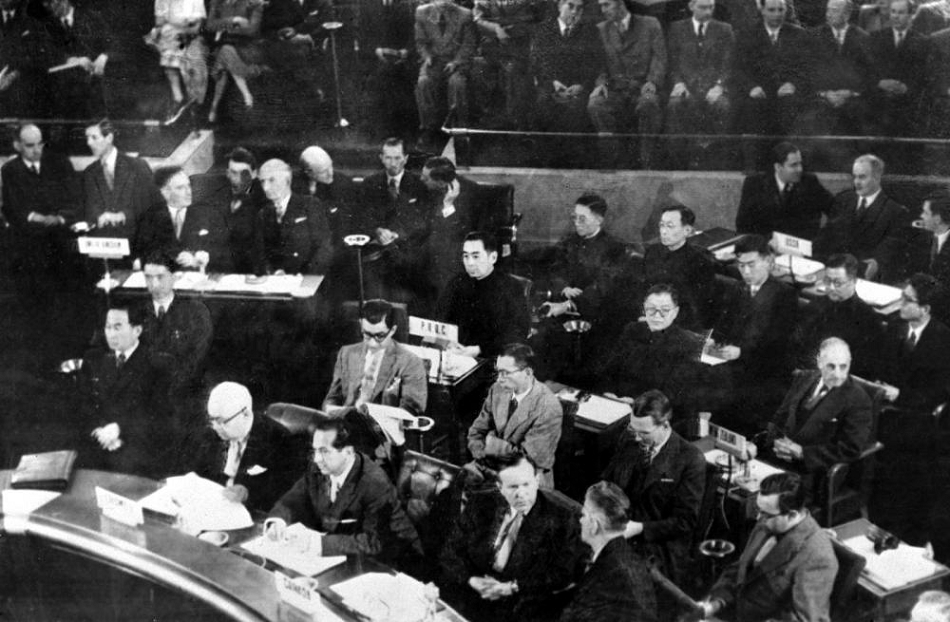
The British (left) Russian
(upper right) and Chinese (center-right) delegations
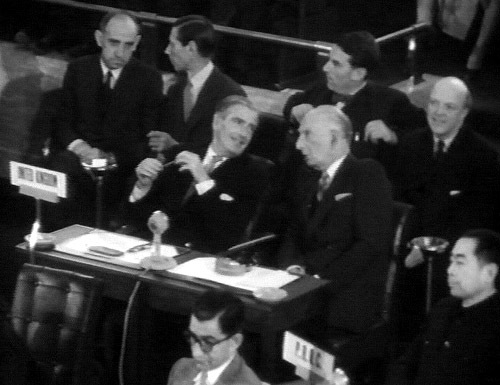 The British delegation
The British delegation
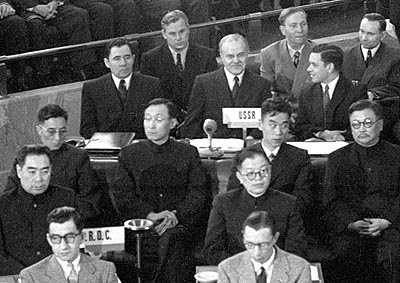
The Russian
(upper) and Chinese (lower) delegations
Under
the provisions of the "Operation Passage to Freedom" any Vietnamese
chosing to move from the North to the South and vice versa were to be
allowed to do so. Actually approximately a million Vietnamese
(most Catholic and many French-speaking) moved South. Only about
50 thousand Vietnamese moved Nort. Pro-Communist southerners had
been instructed to remain in place in the south in case the elections
did not go favorably for Ho Chi Minh - and they could then resume the
struggle to "free Vietnam from Western colonialism."
|

Anticommunist Vietnamese
refugees moving from a French LSM landing ship to the USS
Montague during Operation Passage
to Freedom in August 1954.
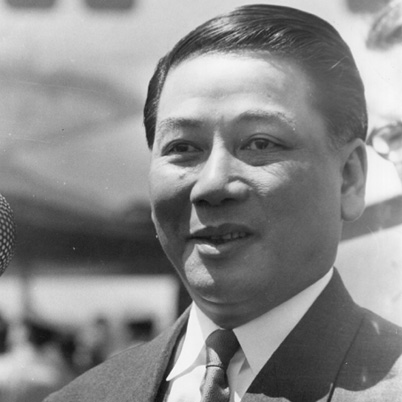
Ngo Dinh Diem - Prime Minister
(and US-supported dictator)
of South Vietnam (1955-1963)
THE "THIRD WORLD" FORMS AT BANDUNG (APRIL 1955) |
With
the former imperial nations of West Europe on clear retreat
internationally and with America and Russia caught up in a Cold War of
their own, it was decided by Indonesian president Sukarno, in getting
mutual support from India's prime minister Nehru, to call a conference
at Bandung in Indonesia ... inviting African and Asian leaders to come
and discuss the possibilities of working together both economically and
diplomatically as the rising new world. They were proposing the
creation of an international alliance of nations "non-aligned" in the
larger Cold War ... an alliance that would constitute what would come
to be termed a "Third World."
Ultimately attending this week-long conference were leaders of 29 Asian and African nations.
This included China ... which did not want to be left out of this
opportunity to register its importance internationally, seeing itself
as the potential leader of what constituted basically an anti-European
(both anti-East and West) independence movement. Thus,
besides helping organize this event, Mao sent his foreign secretary
Zhou Enlai to the conference to align more nations in support of Mao's
efforts to counter Eisenhower's strong support of Taipei rather than
Beijing as the voice of China. And indeed, in this matter Zhou
succeeded grandly.
But other issues rallying the group were: the efforts of France
to hold onto its North African territory (mostly importantly Algeria);
the Dutch about to offer independence to its West New Guinea colony
(which Sukarno wanted to be included as part of Indonesia); and even
the Soviet Union's treatment of Muslim societies ... the latter however
the conference ultimately failing to touch on – instead simply taking
the position that it was opposed to colonialism of any kind, Eastern or
Western.
The conference actually achieved a diplomatic breakthrough on a very
touchy issue ... in getting Sukarno and Zhou to agree to require the
huge Chinese portion of the Indonesian population to end their dual
citizenship status and decide whether they would continue as Chinese or
Indonesian citizens. That would help solve a huge matter of
tension between these two countries (for a while at least).
But otherwise, the conference produced simply a broad agreement among
these countries to work together on this matter of
anti-colonialism. They would stand united as members of the
"Third World."2
2Over
time, various issues weakened the unity of this Third World front ...
the term "Third World" ultimately coming to be merely a term referring
to the poverty and violence that afflicted so many of the Third World
nations.
|
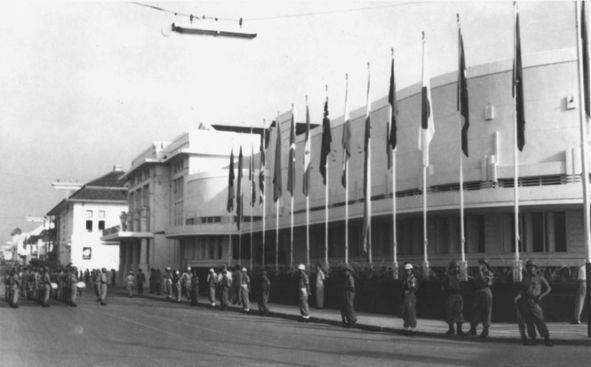
The Bandung Conference
of April 18-24,1955: Gathering of "Non-Aligned" nations (thus neither First World
(presumably the West) or Second World (presumably the Soviet),
but "Third
World"
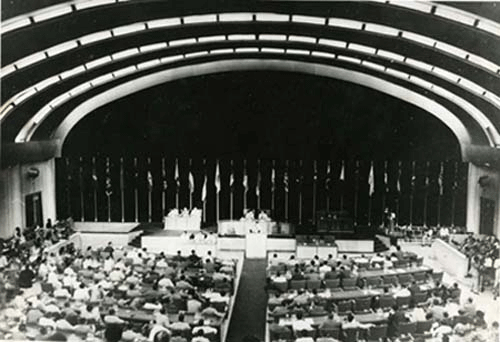
The hall of Gedung Merdeka
where the Conference took place.
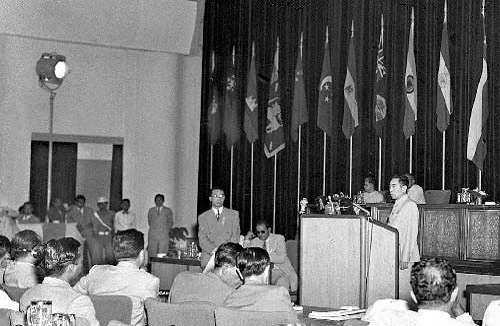
Communist Chinese delegate
Chou En-lai speaking to the conference
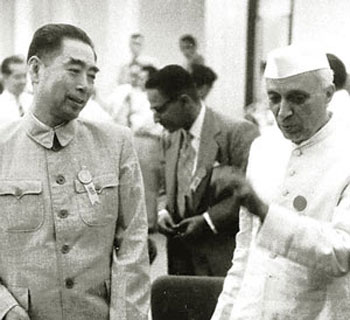
Chou En-lai speaking to Indian
Prime Minister Jahawarlal Nehru
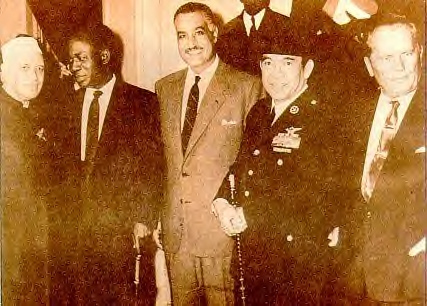 Kwame Nkrumah (2nd from left)
with other co-founders of the Non-Aligned Movement: Nehru of India, Nassar of
Egypt, Sukharno of Indonesia and Tito of Yugoslavia in late 1960
Kwame Nkrumah (2nd from left)
with other co-founders of the Non-Aligned Movement: Nehru of India, Nassar of
Egypt, Sukharno of Indonesia and Tito of Yugoslavia in late 1960
THE REARMING OF GERMANY ... AND THE CREATION OF THE WARSAW PACT (1955) |
Most
interestingly, the creation of NATO in 1949 did not seem to require a
Soviet response. However, the move in 1955 to bring a fully
rearmed West Germany into NATO did in fact inspire a very strong
response … from neighboring Czechoslovakia, East Germany, and Poland –
still recoiling from the horror of the Nazi era – who wanted some kind
of security pact designed to counter possible West German expansion.
This all started back in May of 1952, when Truman – drawing on an
earlier plan (1950) of French prime minister Ren Pleven – pushed hard
to get his European allies to bring West German military potential to
play in the Cold War … by getting them to create their own European
Defense Community (EDC) – with West Germany as one of its
members. But this military union would come fully under the
control of an international authority … just like its strategic coal
and steel industries had been restored – and unified – under the
Schuman Plan's ECSC.
However, even for the French, the "Pleven Plan" was a bit too
frightening. Thus in August of 1954 the French National Assembly
voted "no" in the attempt to ratify the EDC treaty. Italy then
simply refused to put the matter to a vote. The EDC was dead.
Then in 1954, Soviet foreign minister Molotov had proposed the idea of
ending all military alliances of Europeans aimed at other Europeans,
and instead having the Europeans join some kind of larger collective –
but non-military – security organization … one which would include a
reunited (but disarmed) "neutral" Germany, East and West. This
would take place with the withdrawal from Germany of all four occupying
powers and the holding of national elections across Germany.
But in "demilitarizing" Europe (all except the Soviet Union of course)
it was clearly designed to undercut the reason for the existence of
NATO. There was no way that West Europe was willing however
to leave itself without any means of military self-defense.
No … NATO was not going to go away. In fact, with the failure of
the Pleven Plan, it would have to be NATO, not the EDC, which
would have to serve as the means of bringing West Germany forward as a
Western military ally. And thus it was that in May of 1955, West
Germany was brought into NATO as a fully armed military member.
In response to this development, at the very same time (also May of
1955), Soviet Russia and seven other countries of the Eastern Bloc
(Communist Yugoslavia, of course, would not participate) came together
in Warsaw to sign a treaty setting up the Warsaw Treaty Organization
(WTO) … or just simply "the Warsaw Pact."
This now made the military union of the Soviets and their satellite
nations official. And it gave the world a new name for those satellite
nations. They were now the Warsaw Pact nations.
THE SUEZ CRISIS ... AND THE HUNGARIAN UPRISING (OCTOBER-NOVEMBER 1956 |
|
Khrushchev's "New Look" … and a supposed "thaw" in the Cold War
At the 20th Party Congress in late February of 1956, Khrushchev stunned
everyone by strongly denouncing Stalinism in the harshest of
terms. As he saw things, it was time for the Soviets to recognize
that the challenges they faced were ideological, not military or police
matters. There were societies out there watching and deciding
whether they wanted to go the Communist rather than Capitalist
route. Thus it was imperative for Soviet Russia to show that
world the great benefits – not the horrors – of taking the Communist
route. There was a battle going on out there for the minds of men
and women everywhere. In short, it was time for a post-Stalinist
"new look."
Although this address was supposedly delivered to a closed gathering,
in fact it easily found its way to the outside world (as Khrushchev
actually intended) … causing quite a stir within the ranks of the
Party, both in Russia and in the Eastern Bloc. But it also
stirred the larger world – which was trying to interpret what this all
meant with respect to the Cold War that had long been
raging. Was this some kind of "thaw" in that icy Cold War?
The British … and Nasser's Egypt
An area of particular interest to Khrushchev – and equally to the West
– was the Middle East. There, Arab nationalism was stirring
strongly … offering the Soviets a grand opportunity to put themselves
in the middle of political and economic developments which potentially
had a distinctly anti-imperialist (meaning anti-Western) character to
them.
The British had long held a very strong interest in that part of the
world … as it lay directly across the British path to its grand empire
in India. Although the British had not built the vital Suez Canal
which strategically linked India with Europe – in fact it was French
engineers who designed and supervised its construction in the 1860s –
the British were able to buy out the half-ownership of the Canal owned
by the Egyptian king in 1875 – when he fell into huge economic
difficulties. Thus it had been under joint French-British control
since that time. In fact it was this interest in this strategic
position that determined Britain to put itself in the position of
"protector" of the Egyptian government – and the region around it –
since then.
Of course under Atlee's Labour Government, that role had declined
greatly – in line with Britain's departure from Palestine in 1947.
But the British – once again (since 1951) under Churchill and his
Conservative Party – were doing what they could to get themselves back
into a pivotal position in the Middle East. Indeed, Churchill had
succeeded in February of 1955 in putting together a Middle East Treaty
Organization (METO) – better known as the Baghdad Pact – a military
alliance of Britain, Iran, Iraq, Pakistan, and Turkey. America
had supported the venture but had not joined, due to what Secretary of
State Dulles termed the pro-Israel lobby in Congress. Egypt's president
Gamal Abdel Nasser had been asked to join … but he refused to be
closely aligned with Iraq's president Nuri al-Said – with whom he saw
himself in competition for the leadership of the broader Arab world.
Nassar's refusal to join the Baghdad Pact would draw Egypt away from
its former close relations with Britain. And it would certainly
also undercut the importance of METO – which never really developed as
a key player in the international game. But it also inspired
Nasser to begin to portray Egypt's former ally Britain as the Arab
world's biggest problem in its quest to unite the numerous Arab
"nations" that the imperialist British (but joined by the French) had
set up after World War One in order to give themselves the role of
"protector" … when in fact there was only one true Arab "nation" –
namely all of the Arab-speaking world. Nasser saw it as his job
to unite that Arab nation into a single political entity. But
this was what Britain's Iraqi friend al-Said was also trying to
do. Consequently, relations between Egypt and Britain – the
latter since mid-1955 now under Churchill's former deputy, Anthony Eden
– grew hostile.
French problems in North Africa
But things in the Arab world were just as problematic for France …
actually even more so. Algeria, which was located across the
Mediterranean just opposite southern France, had since 1848 been
considered an integral part of France (three of its d partements) … and
had been duly "Frenchified." In fact, neighboring Tunisia and
parts of Morocco – and much of West Africa - also found themselves
under strong French influence.
At this point, some one million ethnic Frenchmen (the colons) –
approximately 10% of the Algerian population (but a much larger
percentage of Algeria's urban population) – lived in Algeria as fairly
successful farmers, shopkeepers, and civil servants.
Additionally, some of the Arab population was well assimilated into
French culture. On the other hand, some of it was truly still wed
to ancient Muslim ways (especially the Bedouin tribesmen of the
interior). But most of the Arab population simply served
relatively silently within the larger, and still mostly alien French
culture that dominated the land.
But by the mid-1950s, the situation in Algeria was becoming
increasingly tense, with the colons and pro-French Arabs finding
themselves targeted by Arab nationalists fighting for Algerian
independence. The independence of Vietnam in 1954, had greatly
inspired the Algerian nationalist groups. But the granting of
independence to Morocco and Tunisia in 1956 had made the Algerian
independence movement even stronger. In response, by this
time, France had over 500,000 troops in Algeria trying to crush the
rebellion. But this merely made an ever-stronger case for
Algerian independence in the thinking of the Algerian Arab
population. And Nasser was playing up this Arab nationalist
political potential in Algeria – to his own personal advantage, of
course – as fully as possible.
Nasser and the Cold War
Meanwhile, Eisenhower and Dulles had become increasingly concerned
about how the Cold War was reshaping itself into an East-West
ideological contest for the loyalties of the rising nations of the
Third World ... with the greatest potential for trouble in the rising
Middle East. Originally America wanted to build an Arab military
alliance with Nasser's Egypt as its key component … but found that
Nasser was interested in being seen as "unaligned."
However, Nassar's interest in building a high dam across the Nile
River to provide the country with electricity did give Eisenhower and
Nasser the possibility of working closely together. Thus America
(joined by Britain) offered a loan of $270 million to Nasser to build
that dam.
But Nasser was also interested in taking on military leadership in the
Arab world … and sought the weaponry designed to give him that
role. Again he looked to America for that aid … but found he did
not like the conditions Americans demanded in the deal. They were
to be used for defensive purposes only and granted only under American
training and supervision. Nasser then turned to the Soviets … and
in September of 1955 was pleased to announce the completion of an arms
deal with the Russians.
Running out of options, in December, America and Britain announced the
pledge of $70 million towards the dam – in the hopes of luring Nasser
Westward. But things did not improve. America was furious
that Nasser extended recognition to Mao's government in China.
And when, in June the following year (1956), the Soviets offered their
own 2% loan worth $1.12 billion to build the dam … in July, America
backed out of its offer of support.
The beginning of the Suez Crisis (July 1956)
This determined Nasser at the end of July to announce the takeover of
the Suez Canal in order to complete the funding for the Aswan Dam
project. He stated that the former owners (Britain and France) would be
compensated for their loss over time. But Britain and France were
not about to be bullied by the seizure ... and planned secretly – with
Israel joining in the venture – to take back the canal and occupy the
canal zone to protect their interests there.
Also motivating the event was that France was furious with Nasser for
the encouragement he gave the Algerian insurrectionists and wanted him
stopped. And Israel was also angry at the support Nasser gave the
Palestinian fedayeen … and for his blocking of their exit at the
Straits of Tiran into the Red Sea.
Sensing a growing international crisis, America tried to get Britain
and France to ease up on any plans for what would constitute an act of
war. Attempts were made to find an international compromise
concerning the administration of the canal and the distribution of the
canal's finances. But none of this proved able to shake British
and French resolve to bring down Nasser.
Indeed, French premier Guy Mollet was deeply disappointed that his NATO
partner America did not understand the importance to France of bringing
Nasser down. After all, Mollet had turned down a Soviet offer to
end their support of the Arab nationalists if they would drop out of
NATO.
And thus their military plans continued to develop ... even while they
went through the meaningless motions of sitting through diplomatic
meetings. Also, Israel's planned military role in this whole
affair was as yet unknown to any but the British and French.
Meanwhile – a student uprising in Hungary (October 1956)
Totally unrelated to what was developing in the Middle East was what
was developing elsewhere … in Soviet-occupied East Europe. Since
Khrushchev's "new look" speech, attitudes had been growing in East
Europe that post-Stalinization also meant post-Sovietization. And
thus on 23 October – at exactly the same time that the world was
focused on the Suez crisis – 20,000 Hungarian students took to the
streets to call for an end of the Soviet occupation of their
country. By that evening about ten times that number had joined
the protest.
This did not happen of course without some kind of buildup. And
that buildup had actually been pushed by America itself … through the
broadcasts of its news network, Radio Free Europe (RFE). Dulles
had issued promises through the RFE that America stood ready to help
any people in overthrowing the Soviet tyranny that oppressed them so
deeply. And the Hungarian students naturally thought that such
help meant direct intervention in case the Soviets should attempt a
counter-move.
Taken by surprise by this event, Khrushchev's response at first was
quite timid, sending in some troops to try to put some sense in things
there … but not in such a way that it would give the appearance that
Stalinism was still quite alive in Soviet Russia. But things
merely worsened for Khrushchev day by day. The purging of
pro-Soviet leaders was increasing and independent governing councils
were rapidly being established in the country. The killing of
pro-Soviet agents and the RFE broadcasts were also becoming very
dramatic indicators of where things stood in Hungary … and in the
rest of East Europe. Something needed to be done. But what?
Simultaneous action at the Suez Canal and in Hungary
Meanwhile, with winter coming on and with increasing pressure in
Parliament for the Eden government to do something about developments
at the Suez Canal, clearly it was high time to make a move. Thus
on 29 October the Israelis struck first, sweeping across the vast Sinai
Desert and hitting an unprepared Egyptian army, forcing it back in fast
retreat. Three days later (November 1st) the British struck the
Egyptian army from the air, finishing off the Egyptian army … and then
several days later dropped British and French paratroopers near the
canal in order to seize it. The action was an immediate and huge
military success for the Israelis, British and French.
But politically and diplomatically, it would prove to be a huge disaster.
Meanwhile on the Hungarian front, Khrushchev remained hesitant about
responding to the rapidly deteriorating situation in Hungary. Mao
was even chiding Khrushchev for looking like such a weak leader.
Then two events finally determined Khrushchev to make a very strong
move on Hungary. One was Hungary's announcement that it would be
leaving the Soviet bloc … and planned to continue as a neutral nation
in international affairs. That was totally inadmissible to
Khrushchev. The other was the British, French and Israeli assault
on Egypt – which not only had the world distracted but which he hoped
would also make a Soviet move on Hungary appear to be no more
imperialistic than the simultaneous British, French and Israeli move on
Egypt.
Thus on November 4th, Khrushchev sent thousands of tanks and hundreds
of thousands of Soviet troops into Hungary to crush the rebellion. It
was a very bloody affair. Over 2,500 Hungarians were killed (but
also 700 Soviet troops) and 20,000 Hungarians wounded (as well as 1,400
Soviet troops). Thousands (20,000 to 30,000?) were arrested,
hundreds executed, and some 200,000 Hungarians fled the country, never
to return.
And although this undercut deeply Khrushchev's "new look" … it brought
things quite quickly back into a proper Soviet order.
Nonetheless, Khrushchev would continue to affirm that he still stood on
the principle of his "new look" … whatever that now meant – for clearly
this had been an action of the Stalinist variety.
The "help" promised by America's RFE never materialized … although the
matter was taken to the U.N. – where of course a call for action was
naturally vetoed by the Soviets. In short, the American
superpower seemed not to be so super-powerful.
Worse, at the same time, America joined with Russia in bringing a
resolution to the U.N. Security Council calling for a ceasefire and an
immediate withdrawal of Britain, France and Israel from Egypt – with
both resolutions vetoed by the British and French. But Eisenhower
remained upset that the actions of the British and French allies had
done far more damage in driving the Arab world into the arms of the
Soviets than what regaining the canal ever offered the British and
French. Furthermore, he was afraid that America's NATO
commitments could have dragged them into a conflict in Egypt in which
America had absolutely no interest whatsoever as a military
action. Eisenhower even went so far as to threaten economic
reprisals against Britain and France if they did not immediately
withdraw from Egypt.
The political-diplomatic fallout from these events
Facing such pressure from America – and from the home-front where
thousands of British had turned out to protest their government's
action in Egypt – Eden's government had to acknowledge that Nasser's
government was now the owner of the canal … and that the British (and
French) would withdraw. For Eden, and for the British in general,
this was a humiliating defeat. Indeed, the event made it quite
clear that the days of Britain as a great world power were over.
It was now simply just another one of the many European nations –
nothing more.
As for France, it too was stung deeply by America standing against it
in the Suez Crisis. And that sting would come to be played for as
much political gain as possible by De Gaulle when he soon returned to
power (1958). He distinctly did not trust – or even much care for
– America.
As for America, it lost considerable face by using none of its power to
counter the Soviet crushing of the Hungarian uprising.
Consequently, any hopes of the Eastern Europeans for American help in
loosening the Soviet grip on their nations was now dead. At the
same time America gained nothing from the Arab world (or the Third
World in general … as Eisenhower wished so much could have been the
case) in its siding with the Soviets in coming up against its British
and French allies (Israel was not yet considered any kind of American
ally at the time).
Indeed, America's behavior raised all kinds of questions as to exactly
where it stood on matters – and exactly how it could be counted on to
support or oppose certain key diplomatic matters. Would America
continue to respect the "all for one – one for all" notion that
underpinned NATO? Or would America act only on the basis of its
own national interest – and on that alone. Basically, all of
America's NATO allies in giving over much of their military sovereignty
to the American-directed military alliance had placed themselves under
what they thought was, in compensation, the promise of American backing
in the conduct of their own national diplomacy. But no such
broader interest was shown by America to its British and French NATO
allies in the Suez Crisis, when their traditional national interests
were involved deeply and a military solution was the only serious
option in the support of those interests. America actually
opposed them.
Sadly, German Chancellor Konrad Adenauer thus grew uneasy about
trusting America to come to Europe's aid (as required by NATO).
Indeed, he became very bitter about America lining itself up with the
Soviets in the Suez Crisis. All of this ultimately influenced
deeply the German decision to draw closer to France in a special
European relationship – one that would grow even deeper between Germany
and France after De Gaulle took over in France.
At the same time, Soviet Russia played big to the Arab world its
support of Nasser … making it appear that the Soviets were their best
friends in their efforts to come out from under Western
imperialism. And though actually the Soviets played the role of
oppressor in the Hungarian matter, it made quite clear that nothing was
seriously going to change in the Soviet mastery of East Europe.
And if anything, it reconfirmed to a rather impressed world that
indeed, under Khrushchev, the Soviets continued to be one of the
world's great superpowers.
And of course now Nasser stood out in the Arab mind as the one person
best able to bring about the Arab dream of an all-Arab republic.
Indeed in 1958, Syria would join with Egypt in setting up just such a
United Arab Republic under the presidency of Nasser. |
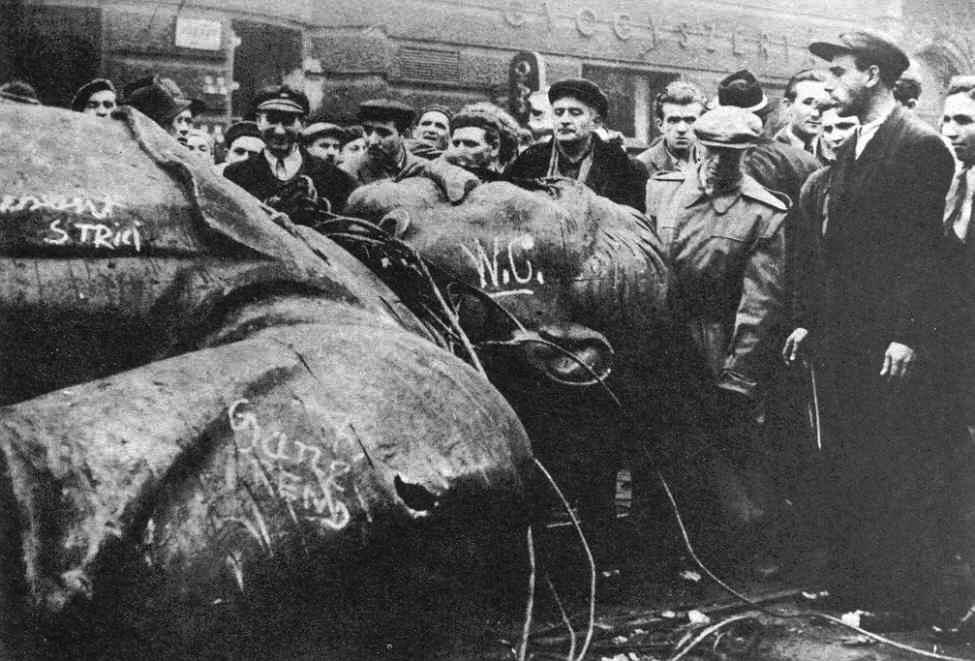
Budapest students and workers
next to a toppled statue of Stalin - at the beginning of the
Hungarian uprising - October 23, 1956
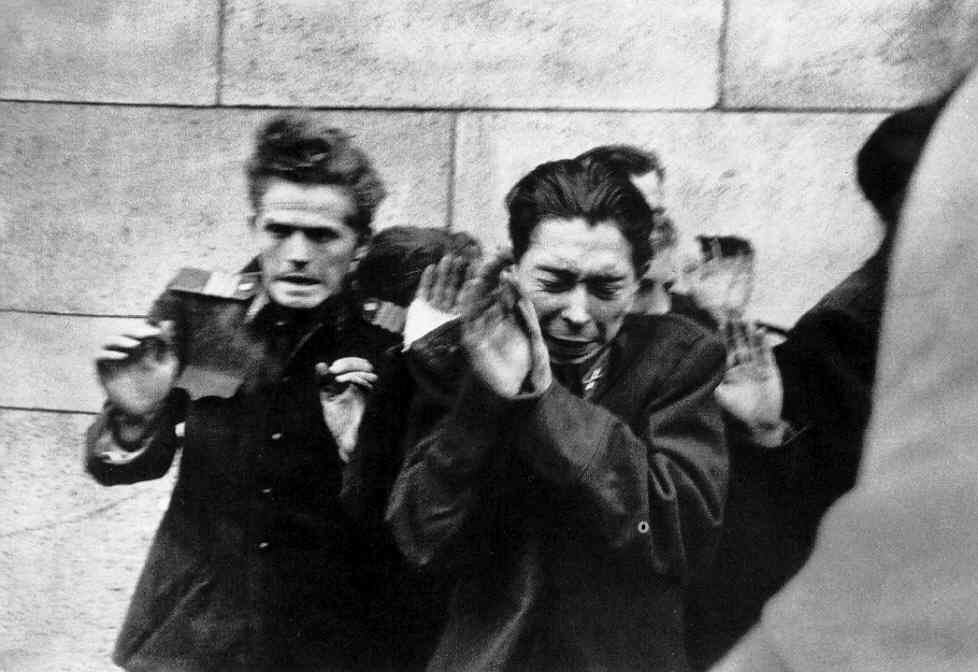
Hungarian security police
being cut down by rebel fire
as they pour out of a Communist
headquarters - November 1956
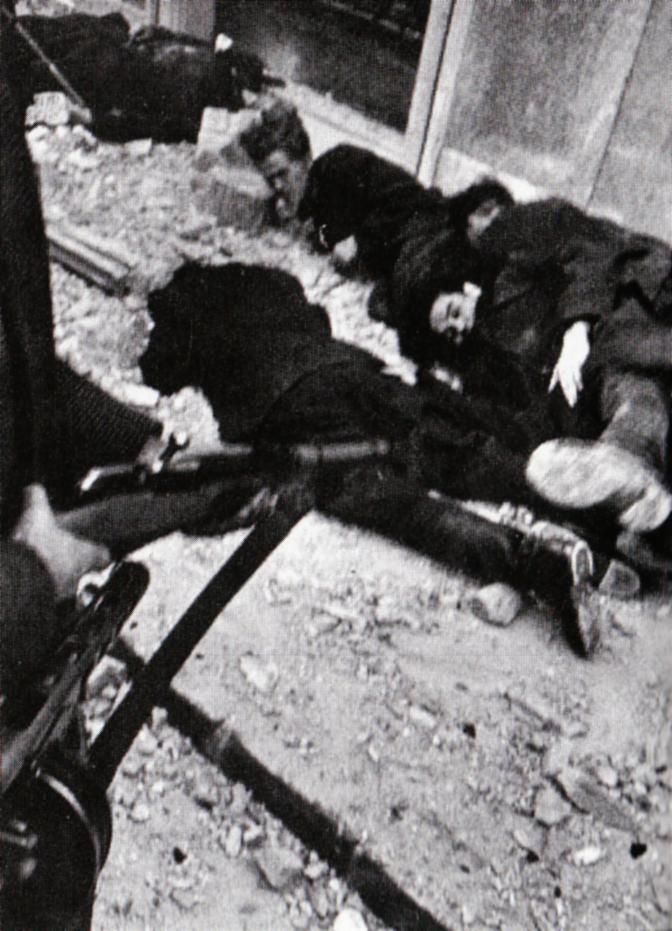
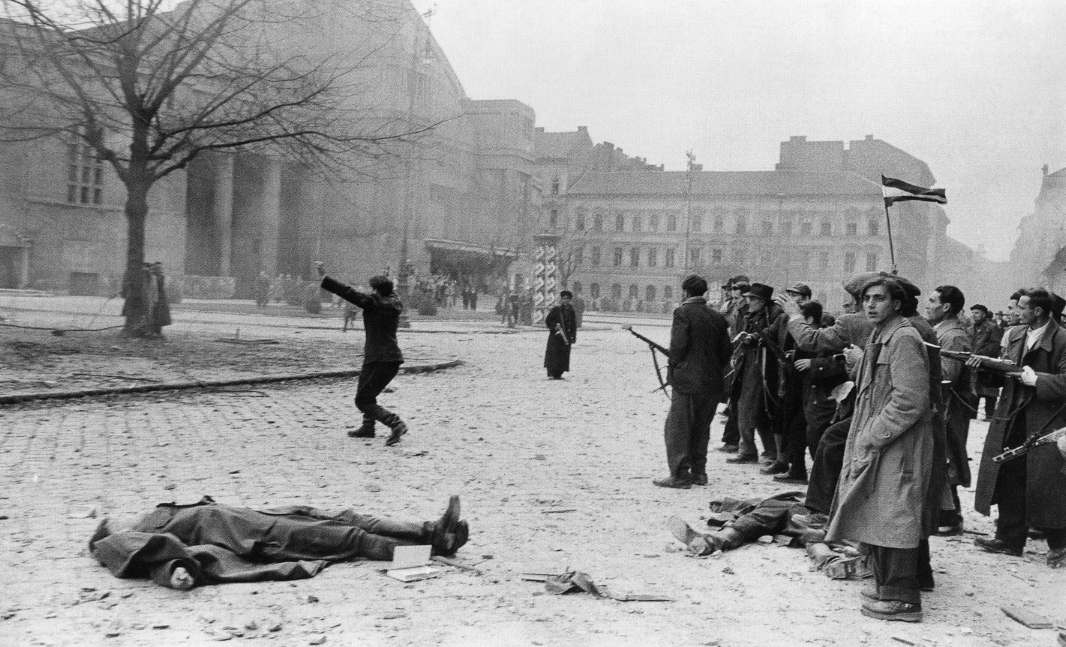
Dead Hungarian secret police
lie at the feet of young protesters in Budapest - November 1956
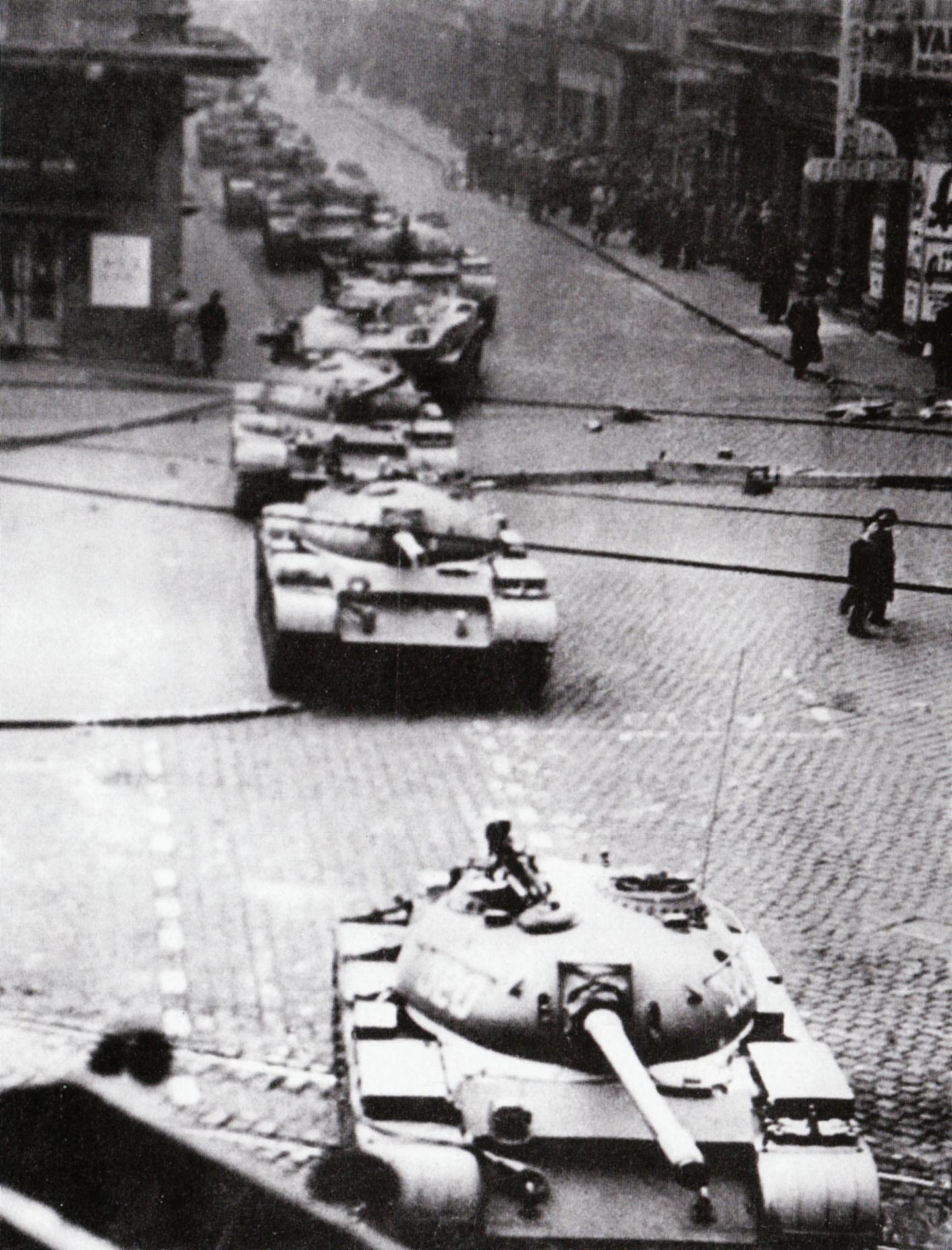
Soviet tanks crushing the
Hungarian uprising in Budapest, November, 1956
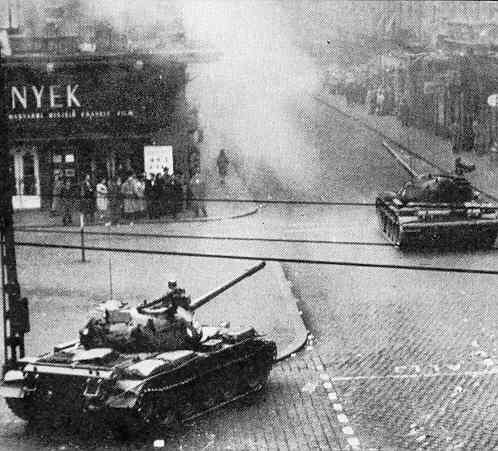 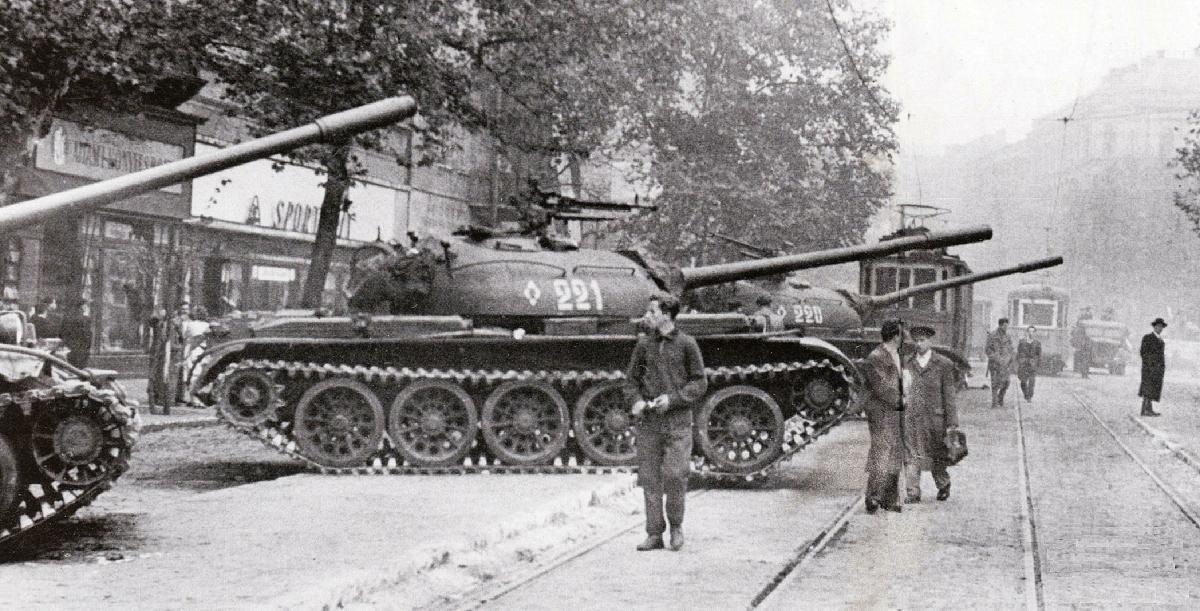
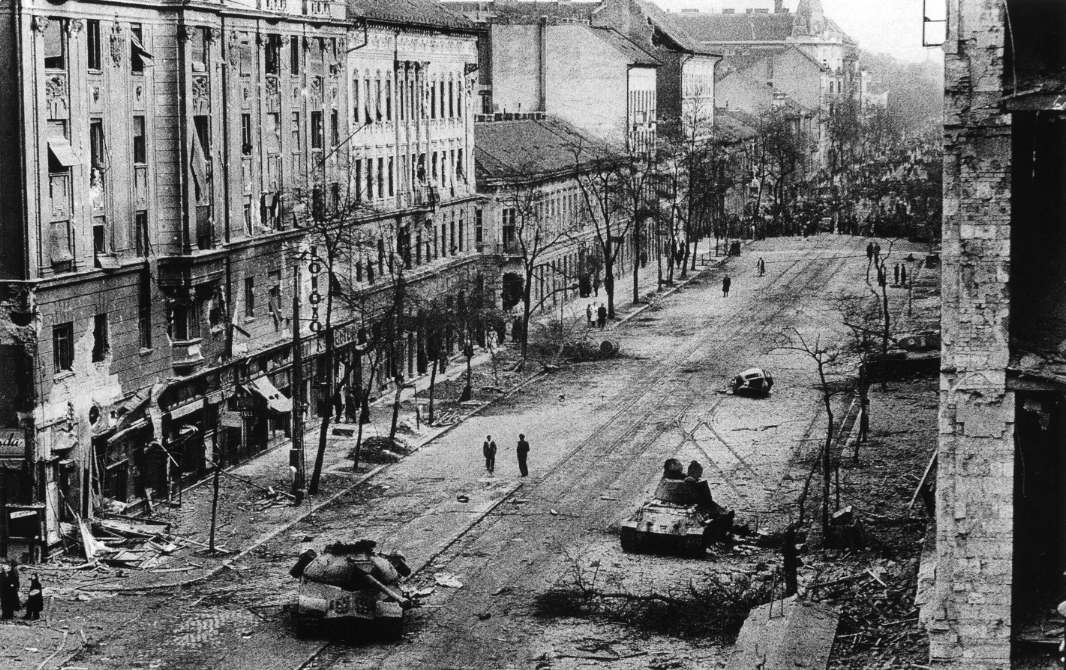
Burned-out Soviet tanks in
Budapest, Hungary - November 1956
Meanwhile in the Suez region of Egypt

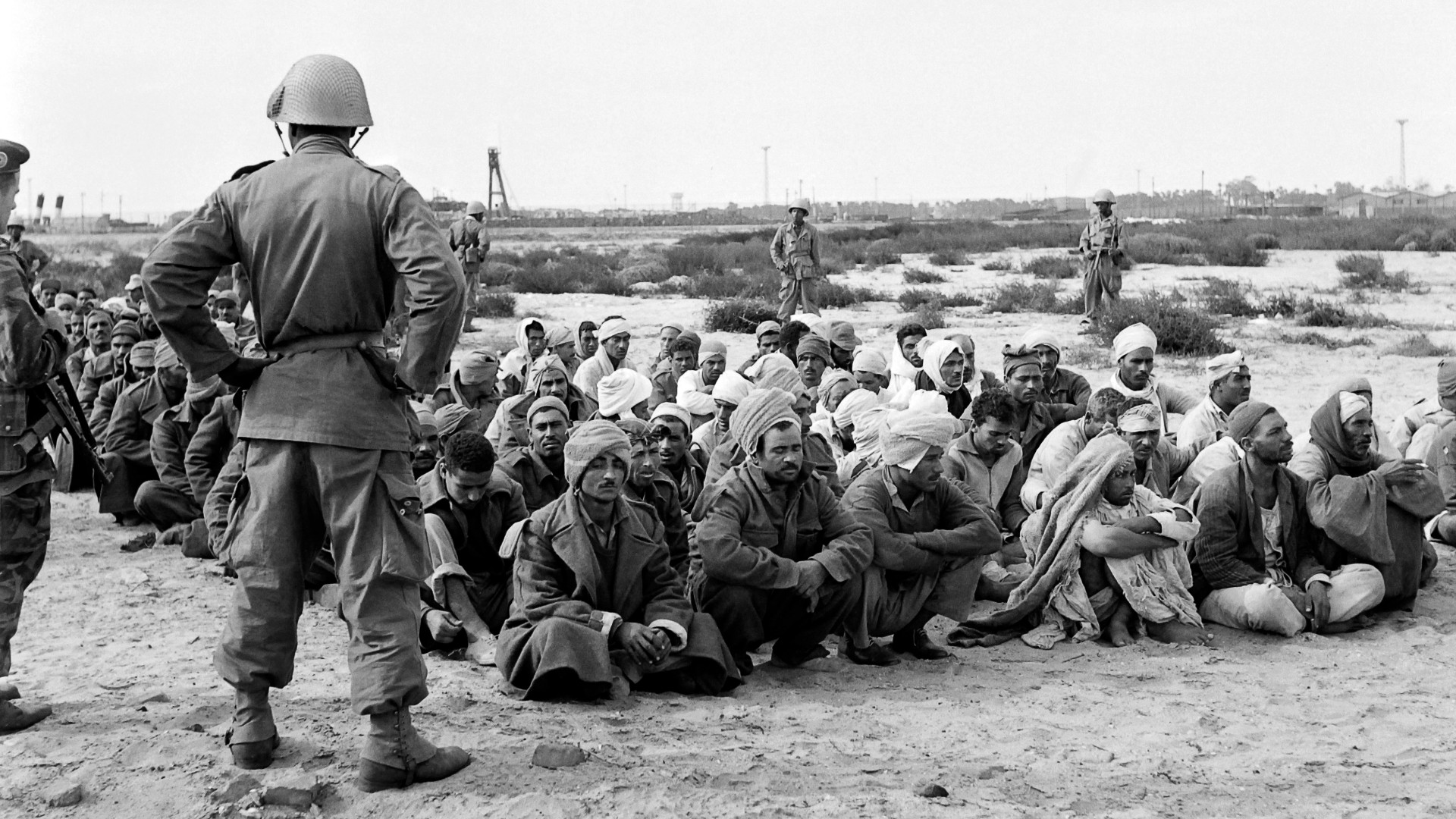
French soldiers with Egyptian prisoners - November 1956
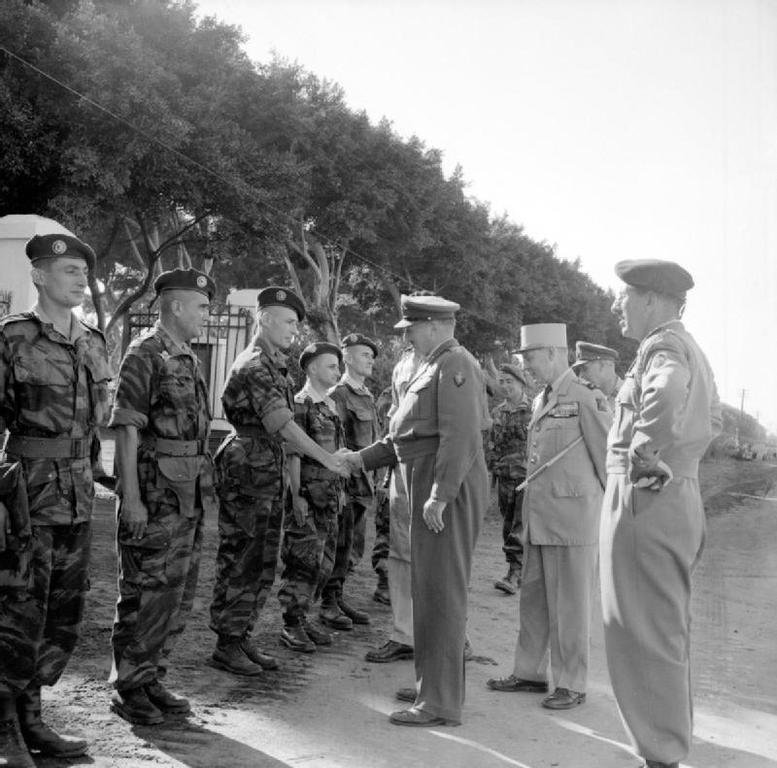
British General Sir Charles Keightley greeting French paratroopers - November 1956
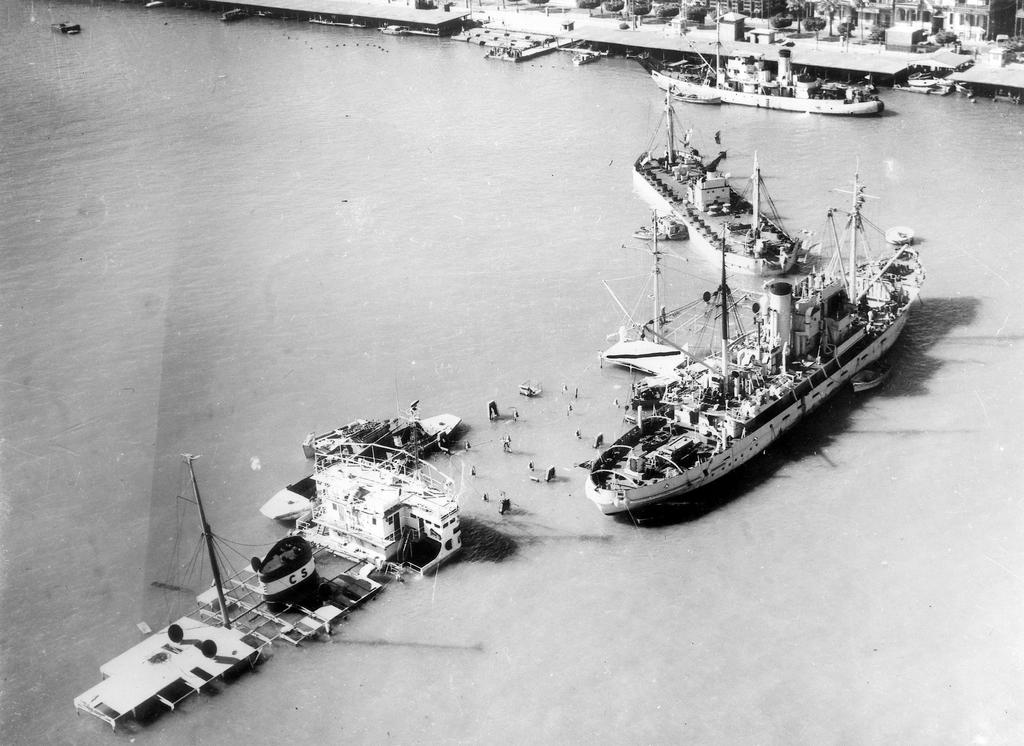
Trying to clear a ship sunk during the Suez Crisis - 1956

Egyptian President Gamal Abdel Nasser greeting fellow Egyptians
AMERICAN PATERNALISM IN THE WESTERN HEMISPHERE |
Ever
since America's issuing of the Monroe Doctrine in 1823, America had
taken on a "protective" role with respect to its Latin-American
neighbors to the south … a protection that differed hardly at all from
what the Europeans saw as their role in Asia and Africa. But that
protection had the qualities of looking out in particular for the
economic interests driving those countries … economic interests
frequently built on American investments in those lands – and the local
officials willing to play the American game and protect those economic
interests from local groups that wanted to seize those assets.
America talked a lot about its grand mission to spread democracy around
the world. But with respect to the governments of these
Latin-American neighbors, America tended to always look the other way
because their associated officials were very dictatorial. In part
this was because dictatorial government was part of their Hispanic
political tradition. But it was also due to the fact that
dictatorship was more or less required of these officials in order to
guarantee the political and economic "stability" that those American
investments required.
And when things did not always measure up to these American
expectations – it was always easiest simply to send in U.S. Marines to
straighten things out!
Guatemala - 1954
A
general strike forced the U.S.-backed conservative President Jorge
Ubico to resign on July 1, 1944. Gen. Juan Federico Ponce then
took over. Then a junta, led by Arana, in October of that year
overthrew the governemnt of Gen. Ponce, opening the way for a new
Guatemalan constitution ... in which Major Francisco Arana was granted
special powers as head of the military ... and promised support
for the presidency six years hence.
That December, Juan Jose Arevalo, a professor of philosophy, was
elected President of Guatemala by 85% of the votes in a fairly free
election. His presidency was 'centrist': anti-Communist,
yet supportive of urban labor unions. However his government
largely ignored the peasant (largely Mayan Indian) countryside where
poverty was severe. Nonetheless the conservative upper class was
very nervous about his support of the labor unions, considering this to
be merely another version of Communism ... with the U.S. became
increasingly suspicious of him as well.
In July of 1949, Arana had been mysteriously assassinated, largely for
personal political reasons, opening the path of rise to leadership of
former Captain Jacobo Arbenz ... and producing a Leftward move in
Guatemala's politics (Arbenz's Salvadoran wife was even a member of the
Communist Party).
Jacobo Arbenz, freely elected as Guatemalan President in 1950, had
displeased the United Fruit Company of Boston by beginning in 1952 to
redistribute 400,000 acres of unused Company land and distributing it
to landless peasants. (A total of 1.5 million acres were
distributed to about 100,00 families; Arbenz gave up 1,700 acres of his
own land under the program).
Arbenz had offered the Company compensation in accordance with the same
value the company had been claiming for the land in its tax returns ($3
per acre) -- but the outraged Company now claimed it was worth 15 times
that amount ($75 per acre)!
Soon the claim was being broadcast by the US government that the land
reform of the Arbenz government was conducted under the guidance of
Soviet Communists ... in violation of the Monroe Doctrine. A
Guatemalan Liberation Army (CIA trained) was fthus ormed to 'liberate'
Guatemala from these Communist influences.
Arbenz understood the implications of this and sensing that his days
were numbered, resigned the presidency on June 27, 1954. A number
of junta regimes came and went in the next days until the government
came finally to rest on the shoulders of Col. Castillo Armas.
The coup to overthrow the "Communist" Arbenz government in 1954 was
thus itself conducted nearly entirely by the CIA – with virtually no
help from any of the Guatemalan population except for the small number
of Guatemalan soldiers (less than 500) flown in by US transports.
The rest of the world, including America's allies in Europe and the
United Nations, was not deceived by the (American-directed) character
of the coup – and used America's own professed democratic ideals to
condemn American "economic colonialism" in Latin America.
Three years later Castillo Armas would be assassinated in another
military takeover ... and three years after that Guatemala would fall
into a state of bloody civil war (lasting over 35 years) involving the
massacre of huge numbers of the Guatemalan population, mostly the Mayan
Indian peasant portion of the population ... the estimated numbers of
dead and missing ranging between 140,000 and 200,000.
|
When politics in Guatemala takes a Leftward turn in the early 1950s,
America once again
intervenes
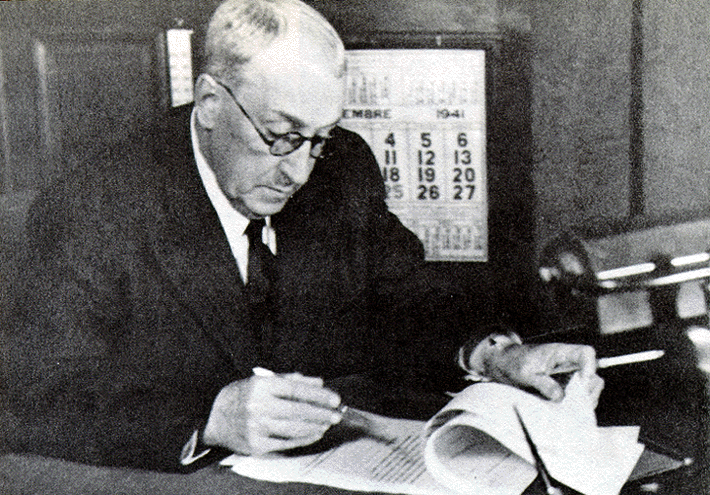
US-backed conservative President
(and dictator since 1930) Jorge Ubico.
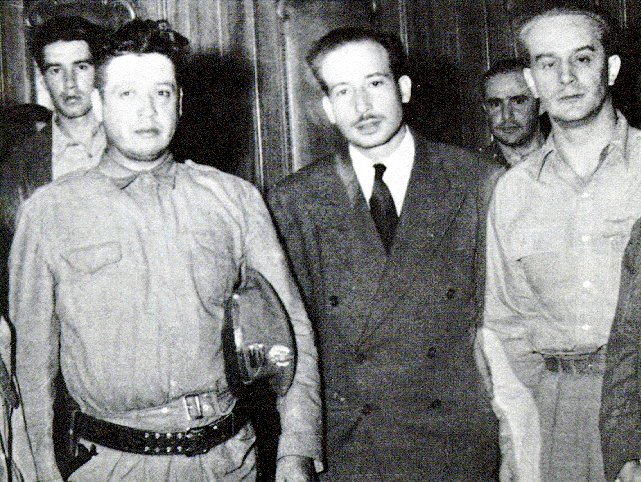
Revolutionary Junta of Oct.
20, 1944: Major Francisco Arana, civilian Jorge Toriello
and Captain Jacobo Arbenz
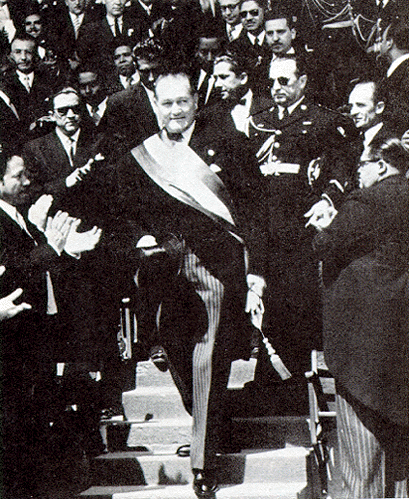
Juan José Arévalo
(a professor of philosophy), elected Guatemalan president
by 85% of the votes in free elections in Dec. 1944
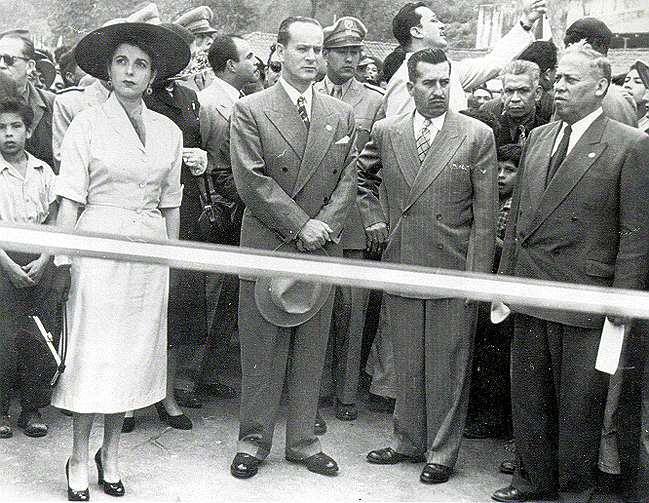
Arbenz and his aristocratic
Salvadoran wife María Vilanova, a member of the Communist
Party
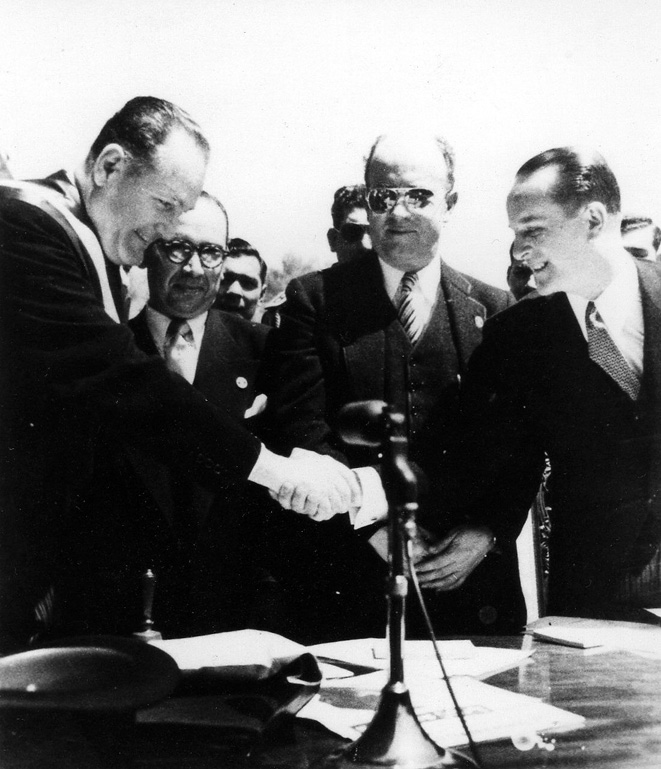 Arévalo passes the
presidency to Arbenz in 1951
Arévalo passes the
presidency to Arbenz in 1951
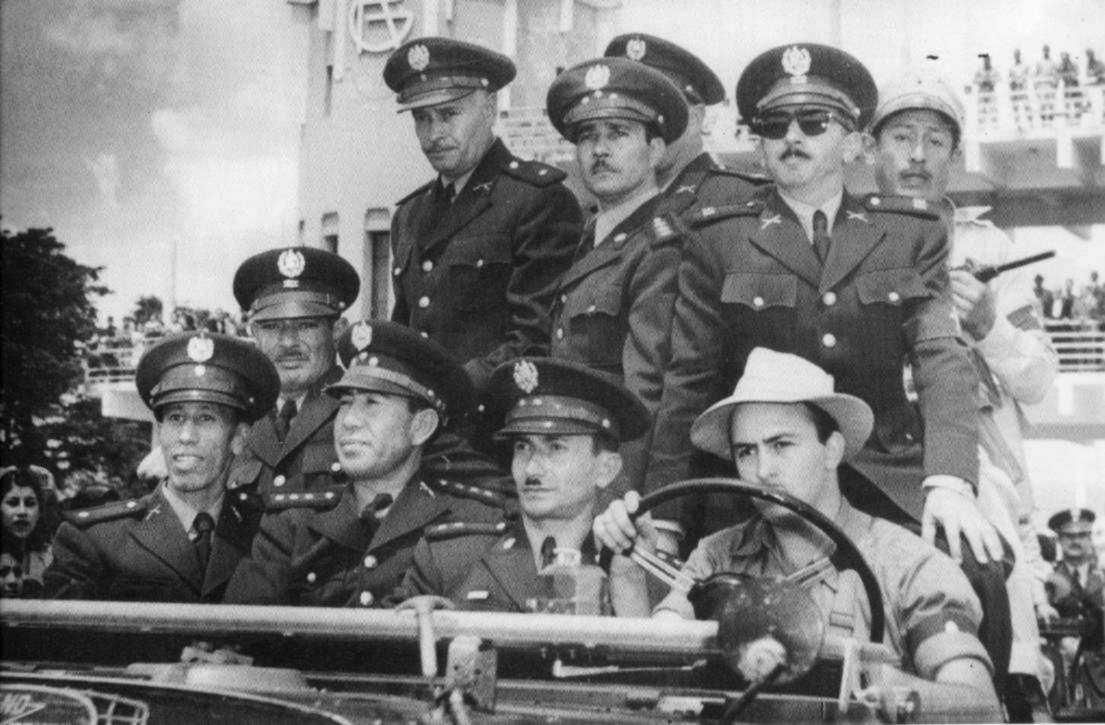
A CIA driver bringing the
CIA's man, Former "Aranista" Castillo Armas (next to him)
into Guatemala
City - 1954
CASTRO'S CUBAN REVOLUTION |
But
the situation could become embarrassingly corrupt … such as in the case
of the Cuban government of Fulgencio Batista. Under his
government not only extensive American interests in a vast number of
industries were put under his protection, but so also was the Mafia in
its business of prostitution, gambling and drugs. Thus Batista
was a very corrupt, but very rich man. It had even come to a
point that the American government itself was becoming quite
embarrassed by his behavior.
Of course there was much local resistance against the Batista regime …
and much sympathy in America toward those who wanted to get rid of
Batista. But the Cold War was also raging at the time (the
mid-1950s) and thus there was equal concern that efforts to dump
Batista might once again profit only the eager Soviets. Caution
was thus required.
One group attempting the overthrow of Batista was led by the young
Socialist lawyer Fidel Castro. He and his brother Raul had attempted a
coup in 1953, had failed and subsequently were imprisoned, then were
released after two years. But once again (1956) they were trying
to remove Batista – Castro now joined by the very colorful Argentinian
doctor Ernesto Che Guevara.
Finally (1958), Eisenhower himself took action to bring Batista under
control, placing an arms embargo on Cuba … and even encouraging the
anti-Batista groups (even Castro's) to rise up against Batista's
corrupt regime. At this point the crusading American press
discovered the colorful Castro, and jumped into the matter, portraying
Fidel Castro in very heroic terms.
Little by little the various groups advanced against a weakening Cuban
army … with Castro's group receiving the greatest attention in the
process. Finally on the first day of January 1959, Batista fled
the country … and, to the roar of the crowds, Castro then entered the
capital Havana as Cuba's new prime minister.
This was the beginning of the purging and even execution of former
Batista officials (state and military). The casinos and hotels
were also shut down … undercutting the Cuban economy greatly. But
with Castro finally able to take full command of the government, in the
typical Socialist manner, huge estates were redistributed as small
plots to the small farmers. But so were even the small
independent farms of Cuba's humbler classes. And although Castro
claimed that he was no Communist, he certainly filled a number of
positions on his cabinet with Communists.
Now opposition to these "reforms" began to grow … as Castro turned on
not only members of the middle and lower-middle classes but also on
other anti-Batista revolutionaries. As Castro's grip on Cuban
society tightened, he forced hundreds, then thousands, to take to the
hills … and even in vast numbers to nearby Florida.
Then when Eisenhower refused to lift the arms embargo he had earlier
imposed on Cuba, Castro turned to the Soviets for military
assistance. Needless to say, Khrushchev was more than happy to
make Russia of great use to a nation just off the coast of America.
Eisenhower then struck back against Castro, cutting back America's
purchase of sugar and the sale of American oil to Cuba … in order to
undercut Castro economically. But this merely opened another door
of opportunity for the Russians – who were quick to purchase that sugar
and sell Cuba oil from Russia's vast reserves. Then
(August-October 1960) when American refineries refused to refine the
Soviet oil, Castro simply nationalized these … plus all other major
American assets in his country (homes, banks, sugar and coffee
plantations).
In turn, Eisenhower closed down all trade between America and Cuba
(October 1960) … and directed the Central Intelligence Agency (CIA) to
gather and train (in Guatemala and Honduras) anti-Castro Cubans in
order to overthrow this growing problem in Cuba. And he set plans
to unleash this liberation force in early 1961 … although he would be
out of office by then. |
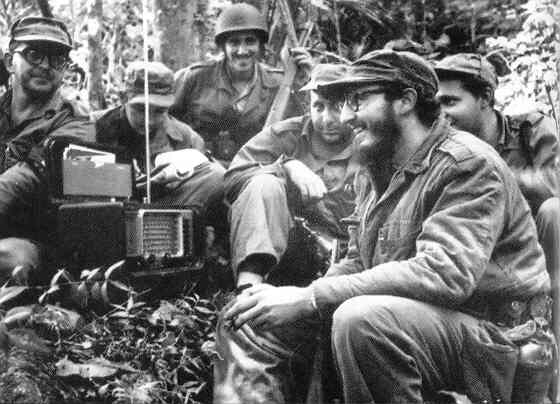
Castro in the Sierra Maestra
with his rebel band - 1957
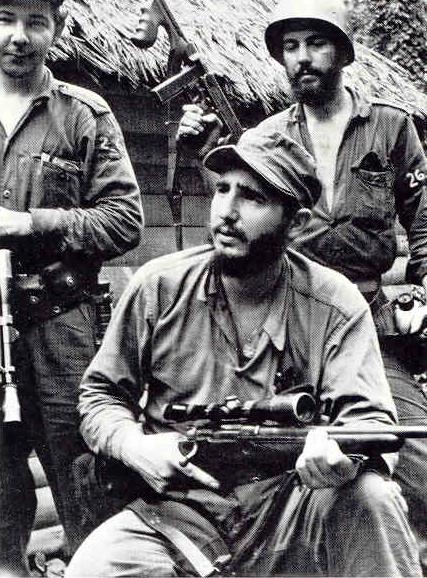 Cuban guerrilla leader Fidel
Castro
Cuban guerrilla leader Fidel
Castro
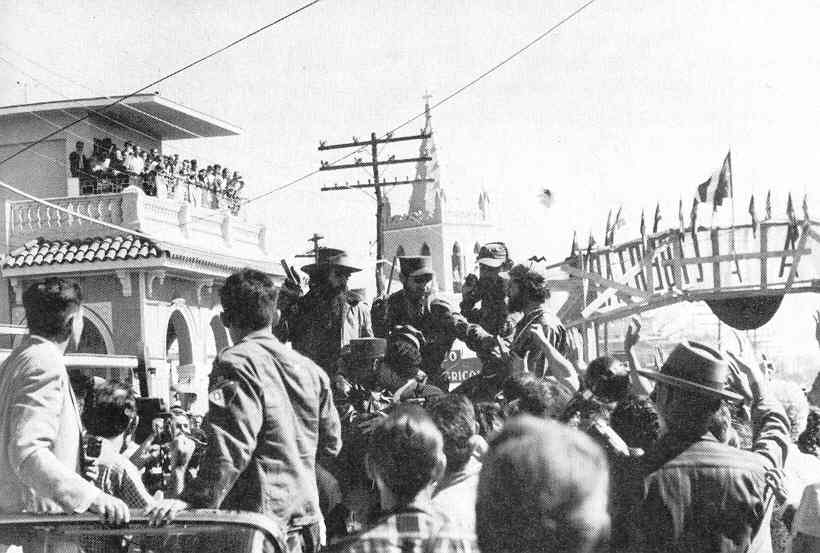
Castro hailed in Cienfuegos,
Cuba, - January 8, 1959, after his overthrow
of the Bastista dictatorship
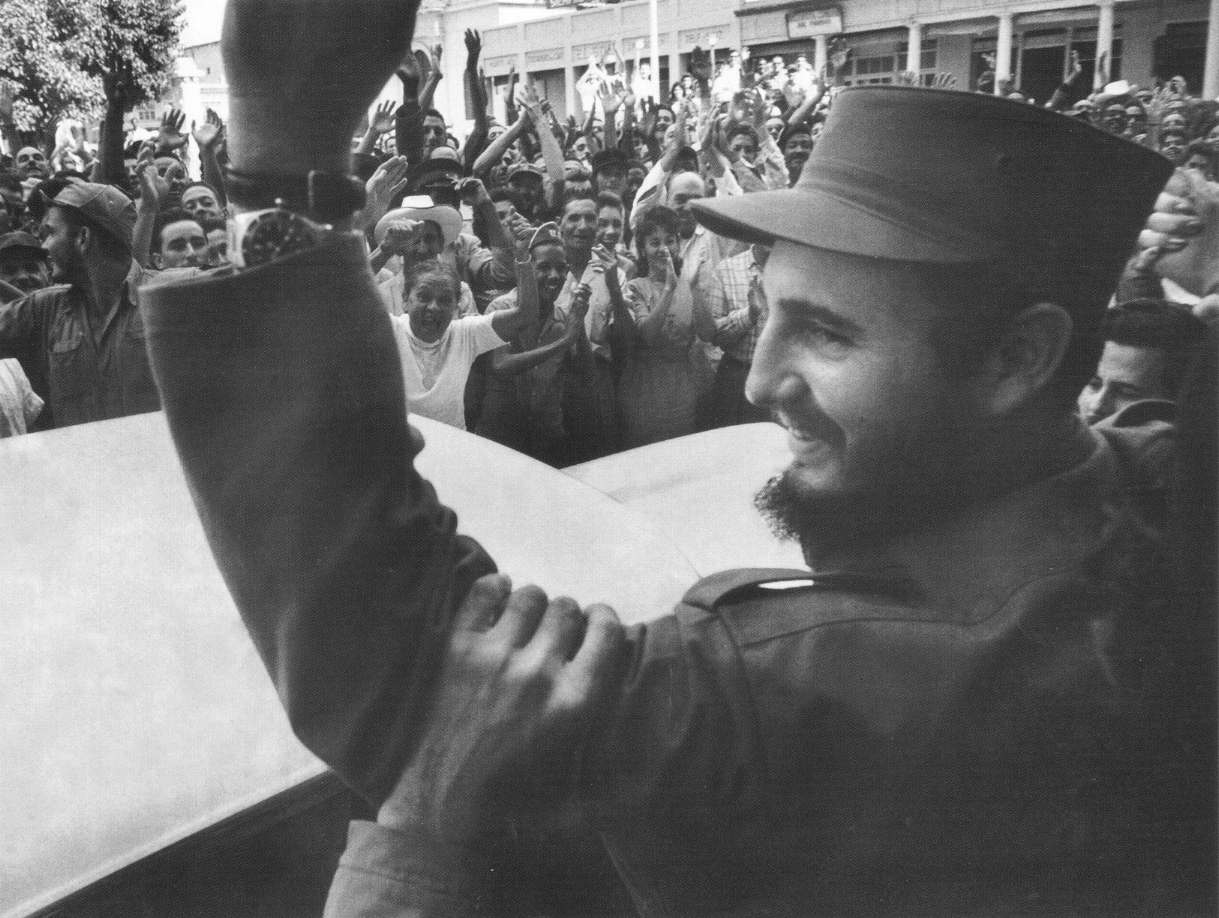
Fidel Castro being cheered
in Cinefuegos, Cuba, after ousting dictator Fulgencio
Batista
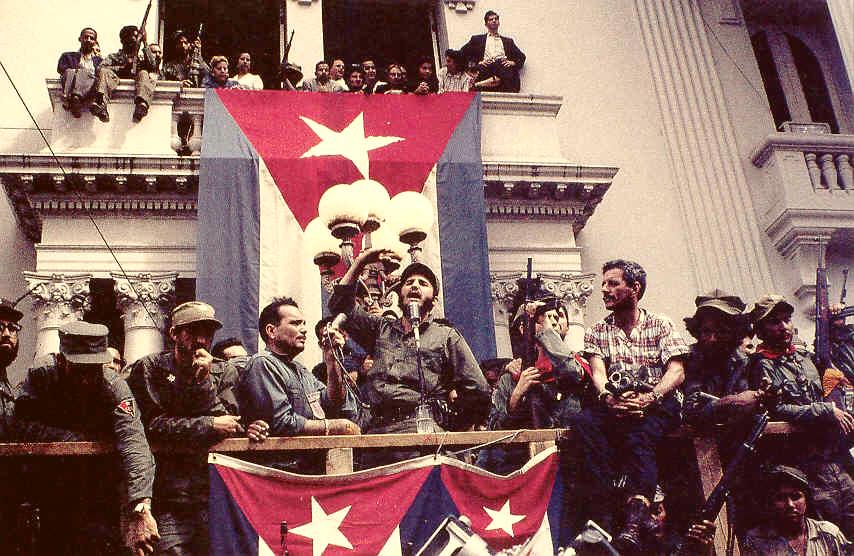 Fidel Castro at the
podium - January 8, 1959
Fidel Castro at the
podium - January 8, 1959
 Castro addressing
Cubans
Castro addressing
Cubans
EUROPEAN RULE UNDER CHALLENGE IN AFRICA |

The British, French, Belgians
and Portuguese are trying to hold on to the remnants of European colonial empire in
Africa – despite very negative views by Americans on the matter
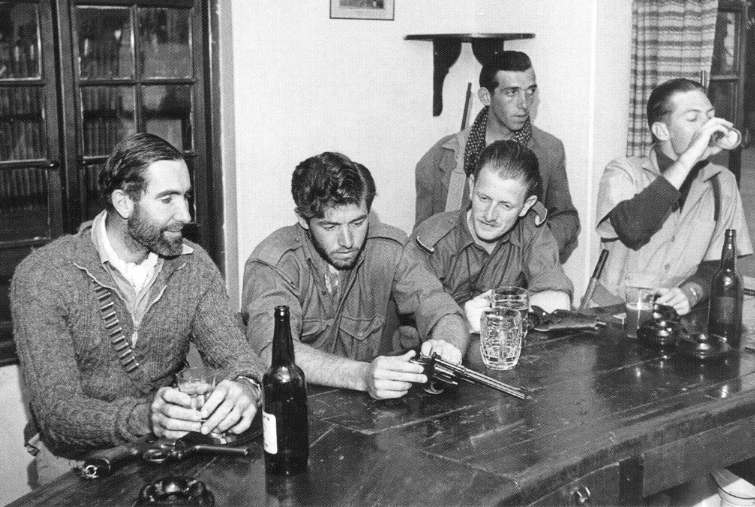
British paramilitaries in
Kenya who fought to hold the colonyagainst a militant Mau-Mau (Kikuyu) independence movement - 1952-1956. Though the Mau Mau were
eventually broken,
British opinion moved in favor of independence
for the colony - which was finally granted in 1963.
An individual who
began to
come to prominence among the Africans in Kenya during this period
was Jomo
Kenyatta
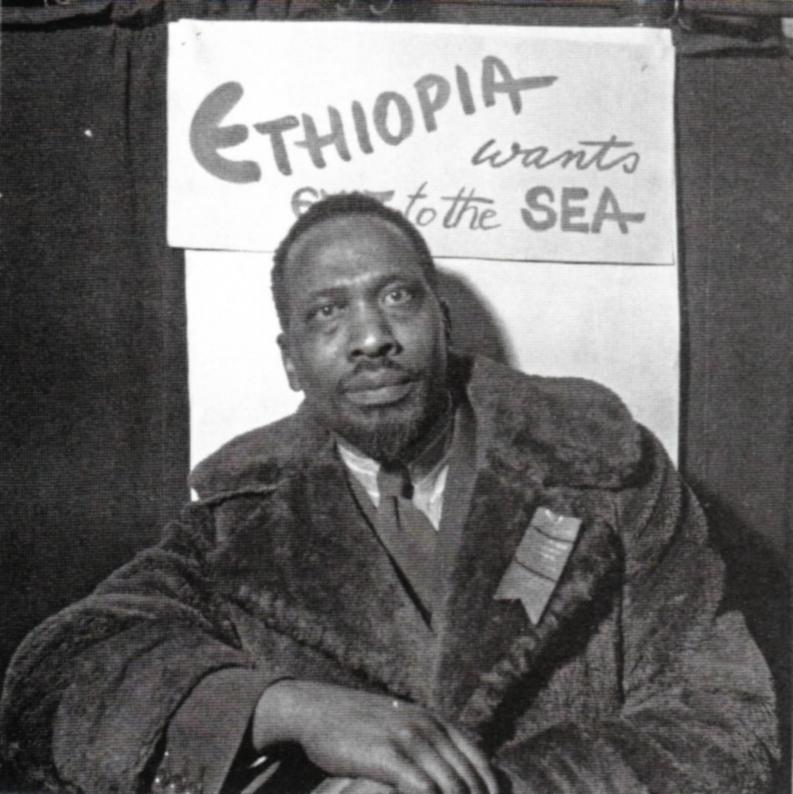
Jomo Kenyatta at the 5th
Pan-African Congress in England which he helped organize - 1945. He would return to Kenya
the next year (after almost 15 years out of the country,
achieving a high
level of Western education)
... to advocate for the
return of the white farms to the Kikuyu tribesmen and for Kenyan
independence.
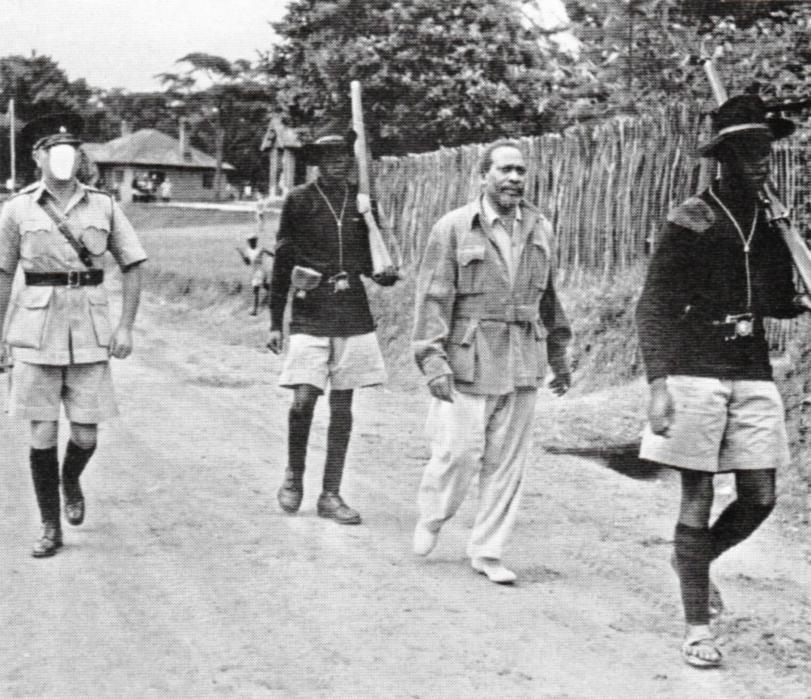
Jomo Kenyatta on trial for
being a Mau Mau leader - 1953. He was imprisoned or detained
from 1953 to 1961 ... and rose quickly to power after his release,
becoming
Kenya's first prime minister in 1963, then President in 1964 when
the constitution was
amended to make the country a full republic (the white officer's face
in this photo has been blotted out to protect him from Mau Mau
revenge)
Sudan moves towards Third-World independence ... by allying itself with Nasser's Egypt
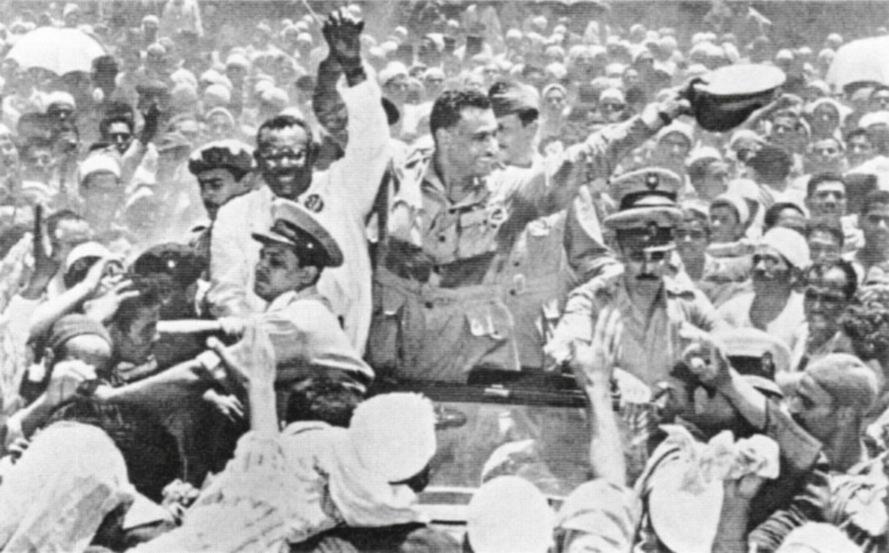
Sudan's Prime Minister Ismail
al-Azhari with Col. Gamal Abdel Nasser in Cairo - 1954
Ghana - the first British
colony in Africa to gain independence (not a lot of whites living there)
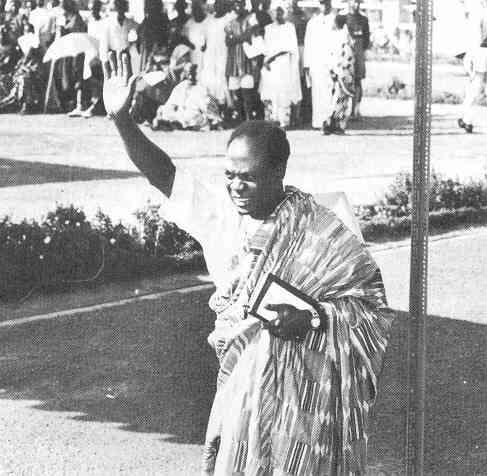
Kwame Nkrumah - outspoken
anti-colonialist who lead Ghana from its
status as the British colony of the Gold Coast
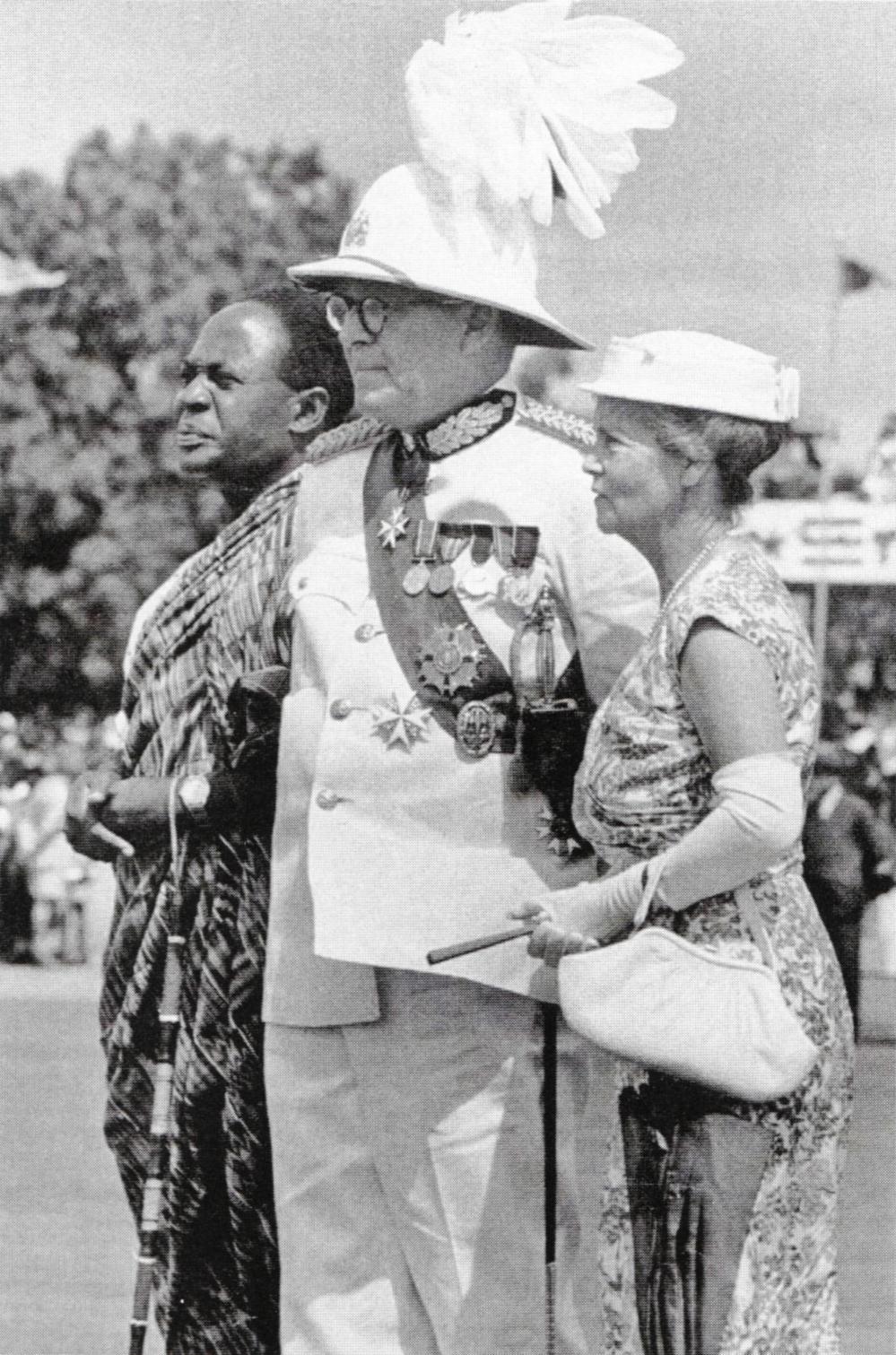
British Sir Charles Arden-Clarke
and Kwame Nkrumah at the ceremonies marking Ghana's independence
from Britain - March 1957
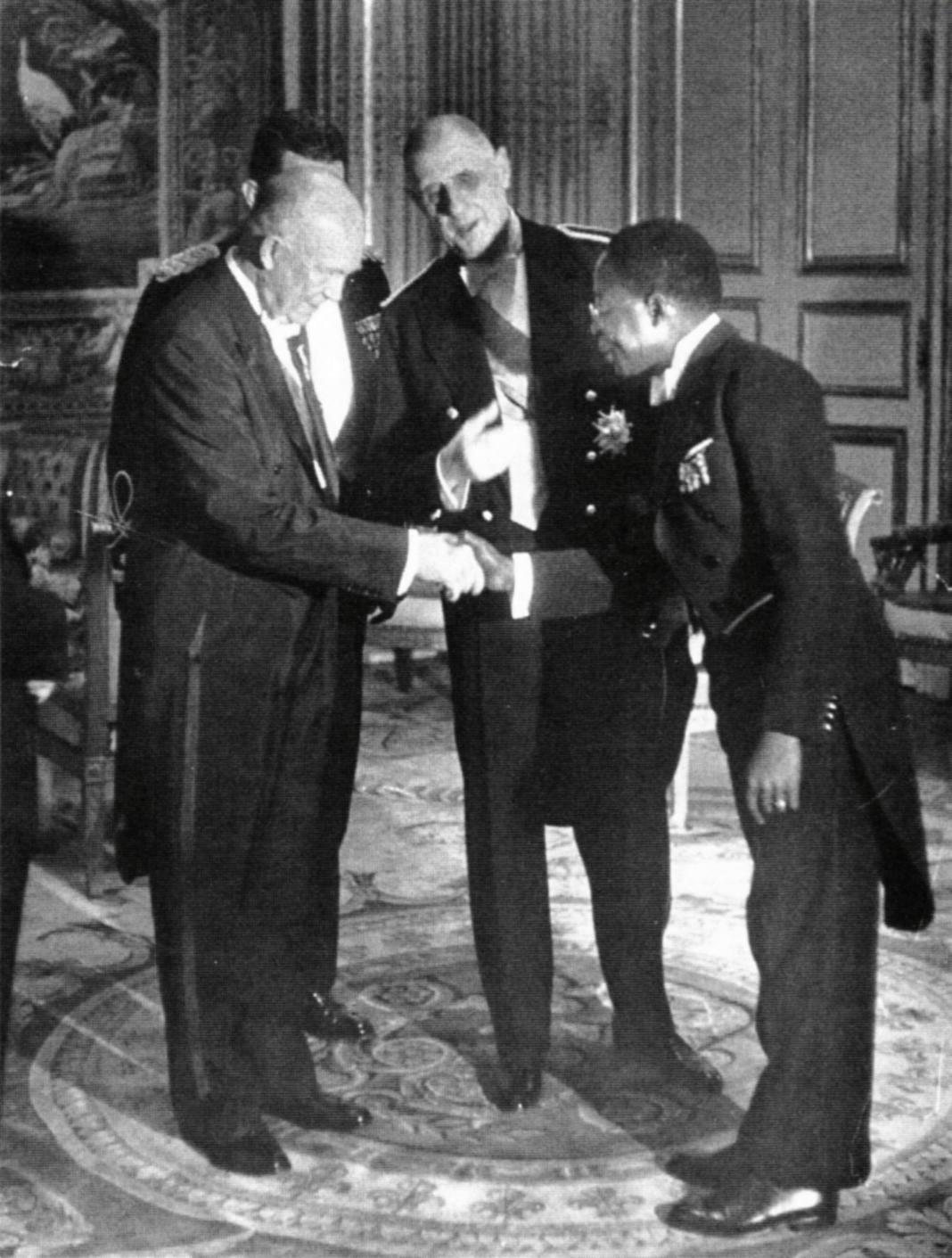
Here are Eisenhower and De Gaulle meeting with the new leader of the Ivory Coast, Houphouet-Boigny in 1959

Go on to the next section: The Settling in of the Bipolar World
 Miles
H. Hodges Miles
H. Hodges
| |


 Stalin dies ... so who's now in charge in
Stalin dies ... so who's now in charge in The French abandon Indochina (1954)
The French abandon Indochina (1954)
 The "Third World" forms at Bandung
The "Third World" forms at Bandung The rearming of Germany ... and the
The rearming of Germany ... and the The Suez Crisis ... and the Hungarian
The Suez Crisis ... and the Hungarian American paternalism in the Western
American paternalism in the Western European rule under challenge in Africa
European rule under challenge in Africa


 Georgy Malenkov (new Prime
Minister)
Georgy Malenkov (new Prime
Minister)
 Nikolai Bulganin
Nikolai Bulganin






























 Kwame Nkrumah (2nd from left)
with other co-founders of the Non-Aligned Movement: Nehru of India, Nassar of
Egypt, Sukharno of Indonesia and Tito of Yugoslavia in late 1960
Kwame Nkrumah (2nd from left)
with other co-founders of the Non-Aligned Movement: Nehru of India, Nassar of
Egypt, Sukharno of Indonesia and Tito of Yugoslavia in late 1960















































